Report

Executive summary
Health and well-being have been steadily growing in importance for consumers and society at large. The Covid-19 pandemic, which has resulted in more than 3.4 million deaths to date, has further increased the urgency to address critical health issues by improving public health and empowering individuals to lead healthier lives. Not only has the pandemic created an unprecedented strain as healthcare systems dealt with mass influxes of Covid-19 patients, it also has had a huge impact on health awareness, including issues such as increased need for mental health services and rising concerns about lifestyle risk factors such as alcohol consumption, smoking, and obesity. A staggering 79.1% of people who have been hospitalized, required a ventilator, or died from Covid-19 in the US were either overweight or obese.
Governments are acting through public health education, more stringent regulation, and greater pressure on manufacturers and retailers to provide consumers with healthier propositions. This comes at a time when consumer interest in health has reached historic levels. Across the US, China, and four European countries, an average of 53% of consumers say they now care more about their health, and 42% of European consumers now report spending more on healthier or nonprocessed foods compared with before the Covid-19 pandemic.
Written in collaboration with
Written in collaboration with

The Consumer Goods Forum (CGF), a CEO-led global network of some 400 retailers, manufacturers, and other industry stakeholders, has launched the Collaboration for Healthier Lives (CHL), a coalition to help people in communities across the globe to live healthier lives while creating shared value for businesses. Over the past three years, CHL has launched 71 local programs across 13 countries, varying in type, feasibility, and degree of success. The programs involve efforts such as advertising campaigns to foster healthier lifestyle habits and encourage switching to healthier options as well as promotional pricing on healthier product ranges. All told, they include more than 800 individual interventions (such as in-store promotions) and reach more than an estimated 2.6 billion consumers, based on a CHL internal assessment.
An assessment of CHL programs to date conducted by Bain & Company, which included self-evaluations by participating companies in each country and a review of academic literature on the topic, shows that personalization through digital activation and altering the shopper environment through means such as promotional pricing, product positioning, or changes to the actual product via reformulation or portion-size reduction are the approaches that have the greatest success in inspiring lasting behavioral change. Such programs are more successful than consumer education, for example. Retailers and manufacturers also claim to generally prefer digital programs over physical in-store programs. Digital programs are considered easier to implement, personalize for targeted end consumers, and scale.
Bain's Joëlle de Montgolfier and Leah Johns review how The Consumer Goods Forum’s Collaboration for Healthier Lives coalition can build on its successes.
Going forward, given its unique position at the intersection of manufacturers and retailers, CHL should aim to skew its mix of programs toward more of those that alter the environment as opposed to those that just focus on educating consumers or increasing awareness. This is especially the case for food-based programs. Awareness, however, may play a greater role in nonfood categories that are viewed as inherently healthy (e.g., hygiene products) and where category growth is the primary aim.
Studying programs that were most effective in changing consumer behavior enabled us to identify four key success factors that manufacturers, retailers, and voluntary private sector members should consider when designing health programs:
- Build programs that are ideally personalized or at least targeted and segmented based on deep, actionable consumer insights.
- Anchor the program in health objectives set by local authorities (e.g., healthier aging in Japan vs. reduction of obesity in the US), with a bias toward speed and action to avoid unnecessary reinvention from the ground up and delay while trying to reach consensus among coalition participants.
- Go beyond consumer education and awareness, altering the consumer and shopper environment so that healthier choices become the default for consumers (e.g., innovation and reformulation of healthier SKUs, making healthier options more prominent or accessible through pricing) while remaining commercially viable for participating companies.
- Ensure that impact can be measured against a clear definition of success that is agreed upon before the program starts, including actual consumer impact or reach and commercial viability for participating companies, with the goal of identifying those programs that are most successful and allow for seamless implementation.
Indeed, rolling out successful programs is a critical next step, and there are several ways to scale. Participating companies can agree to add more products or categories, for example, or to expand geographically to more stores. Moreover, they can extend a program’s time period or involve more participants among retailers, manufacturers, and other partners.
There are a number of key considerations for scaling programs.
- Set up programs for scaling from the outset. Maintain clear objectives and scope; designate the right sponsor, leader, and team; and build scaling into the upfront design process.
- Demonstrate the impact and commercial viability of pilots you plan to scale. Engage and align stakeholders around a common set of health objectives (e.g., improve life expectancy, reduce sodium).
- Leverage digital, data, and external partnerships—especially where in-house capabilities are lacking.
Although CHL has achieved significant tangible results to date, it can build on that success by focusing on its core mission and prioritizing existing and future programs around those shown to be most effective. Further, it can benefit from improving the current system for knowledge sharing, finding a way for participants to codify and access the most critical learnings easily while on the go, then keeping those learnings up-to-date and easily obtainable for all.
Health—a human, societal, and business urgency
Health and well-being have been growing in importance for consumers and societies. For instance, a 2018 IRI survey showed that roughly 70% of people across Europe were buying healthier foods (with less salt, sugar, fat, or calories), representing an increase of more than 40% in just three years.
The Covid-19 pandemic has now accelerated this health consciousness as consumers come face-to-face with the consequences of lifestyle risks (see Figure 1).
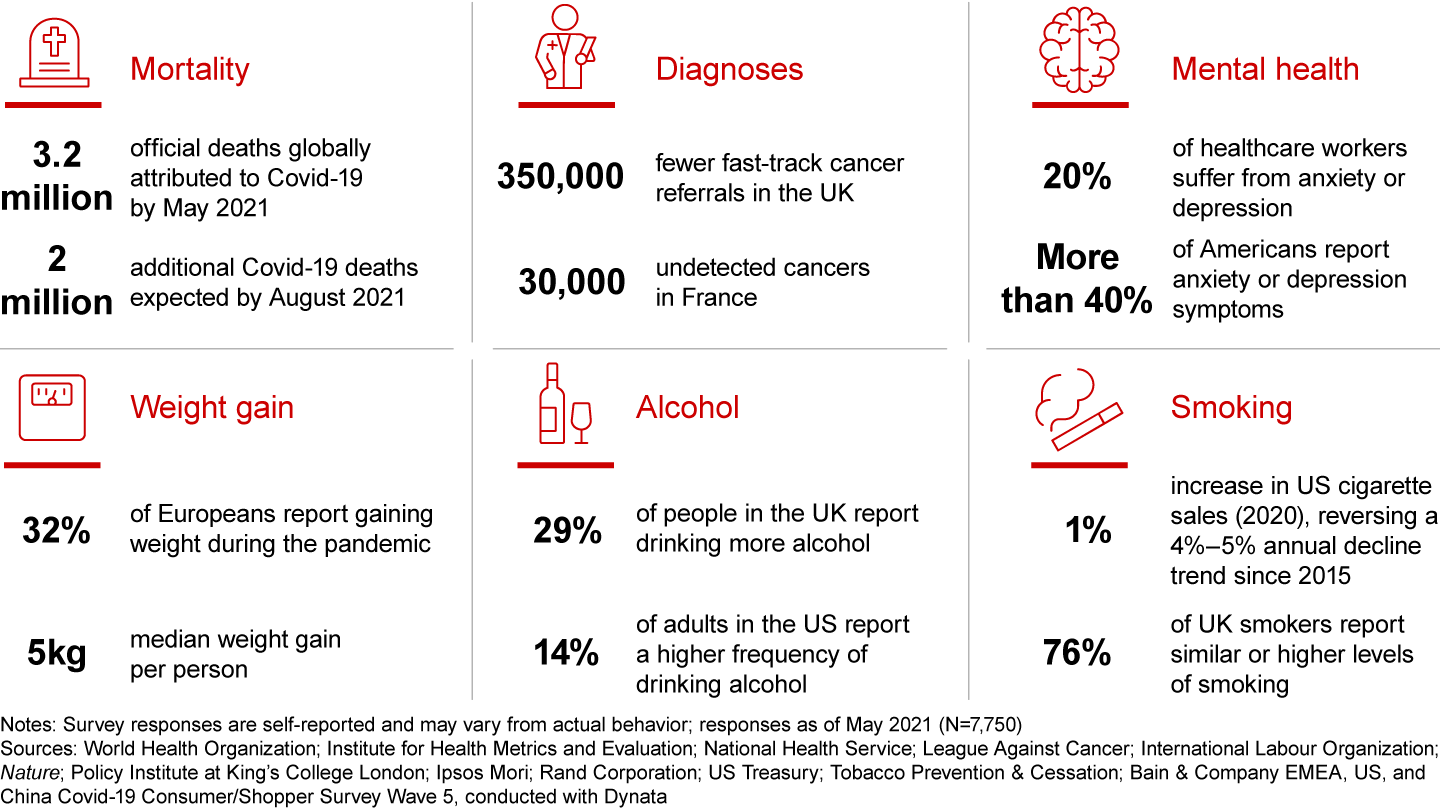
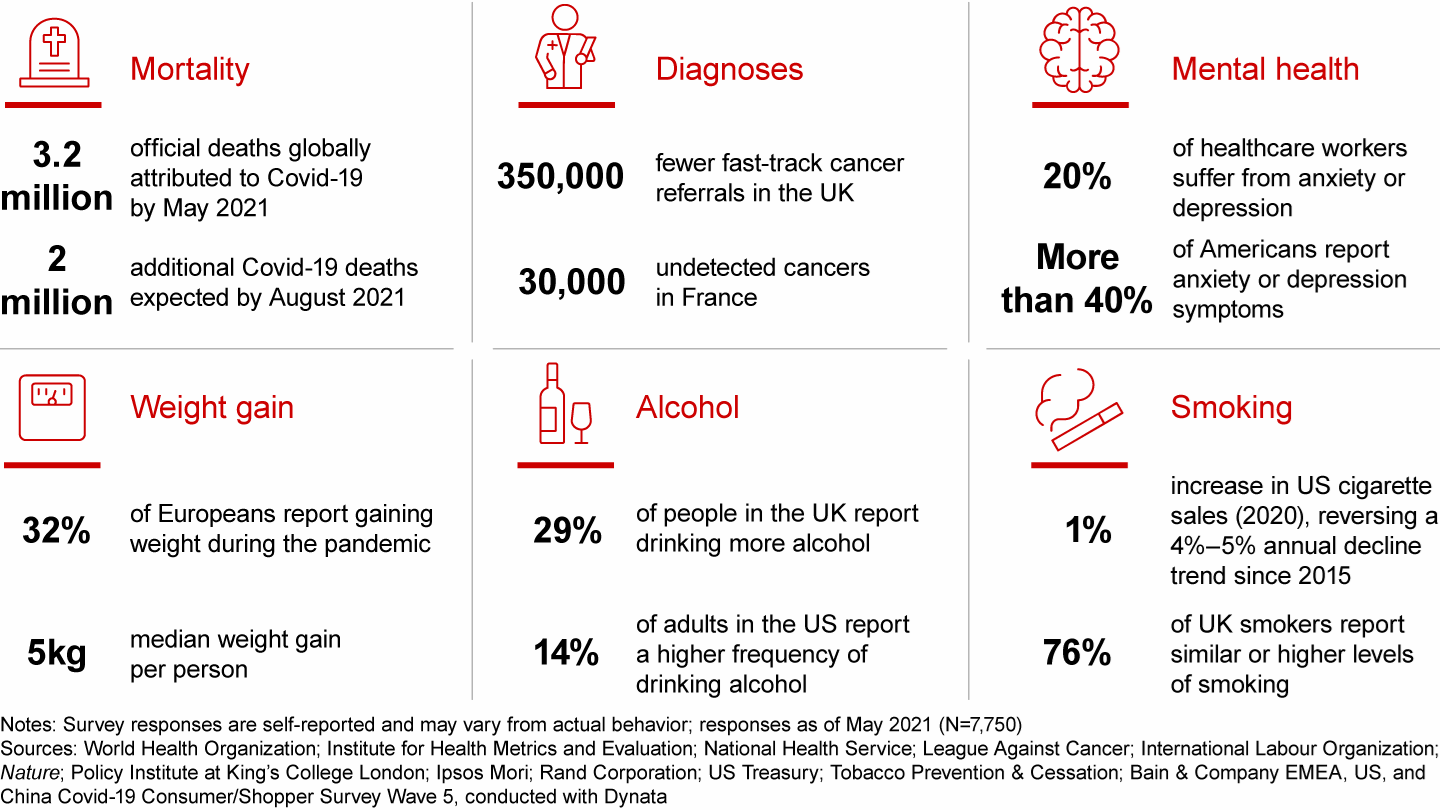
The US Centers for Disease Control and Prevention found that a staggering 79.1% of people who were hospitalized, required a ventilator, or died from Covid-19 were overweight or obese. Such findings are not lost on consumers. A 2021 Bain & Company survey found that 47% of US, 48% of European, and 81% of Chinese consumers care more about their health than they did before the pandemic, and a portion of those respondents chose to adopt lifestyle changes, such as eating healthier foods, getting fit, or losing weight (see Figures 2, 3, and 4).
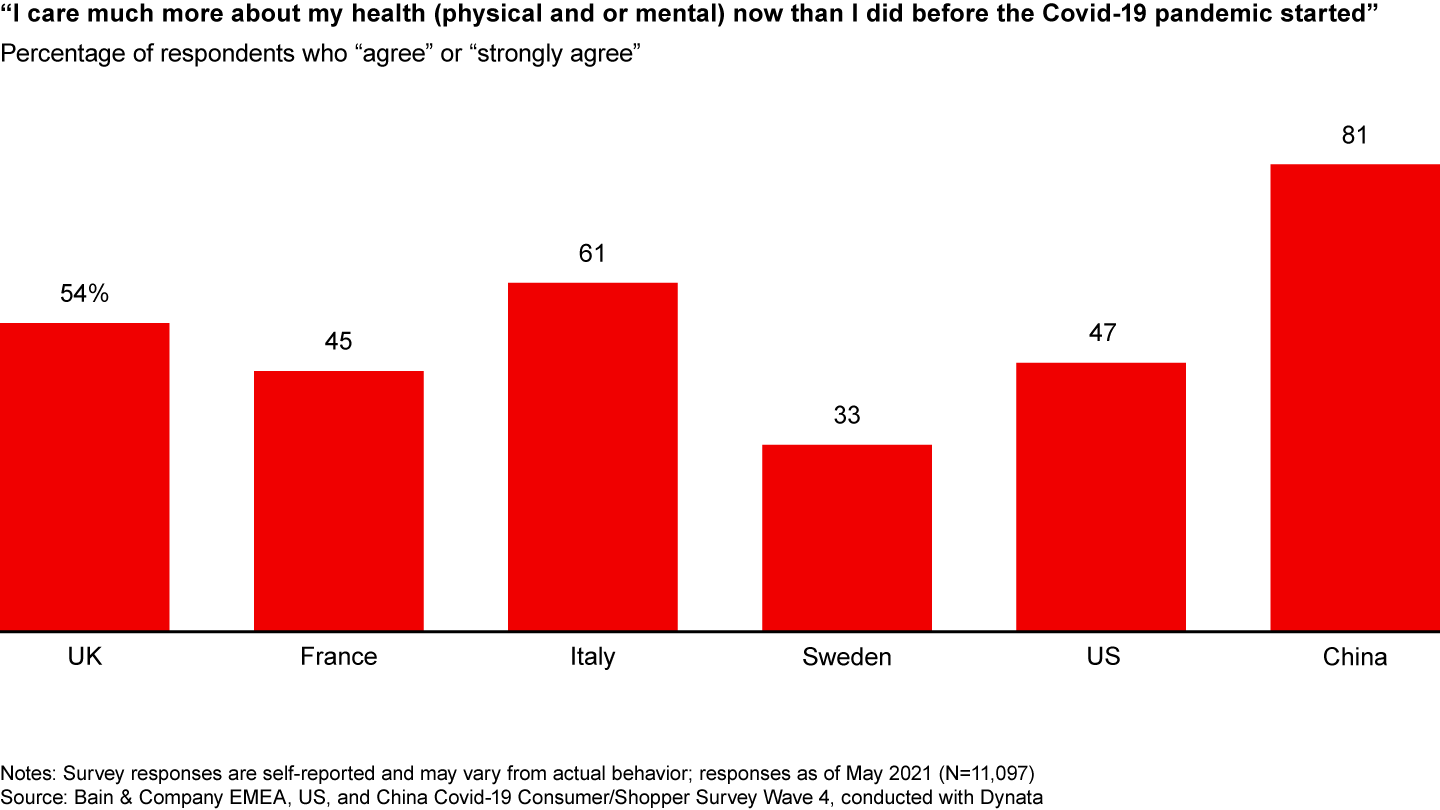
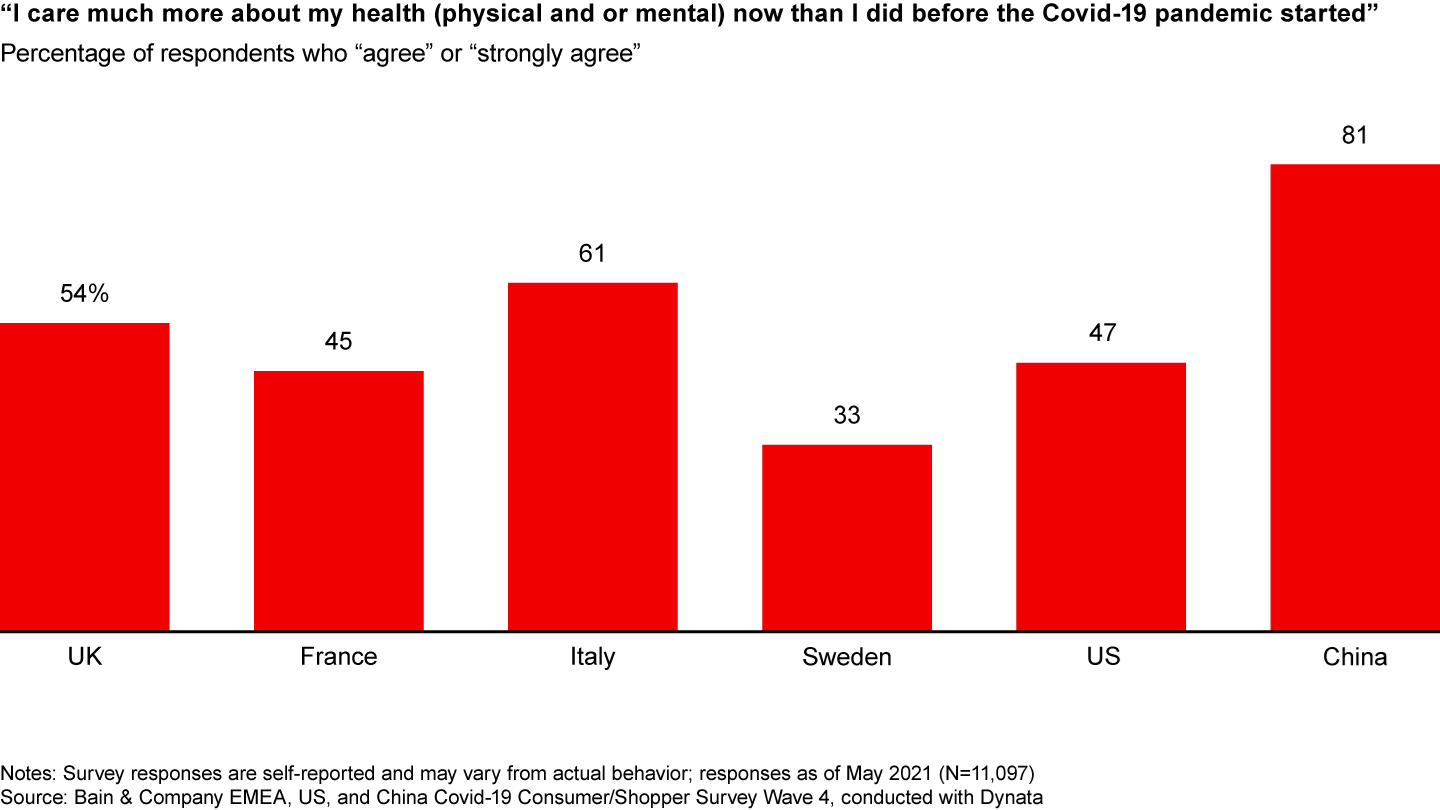
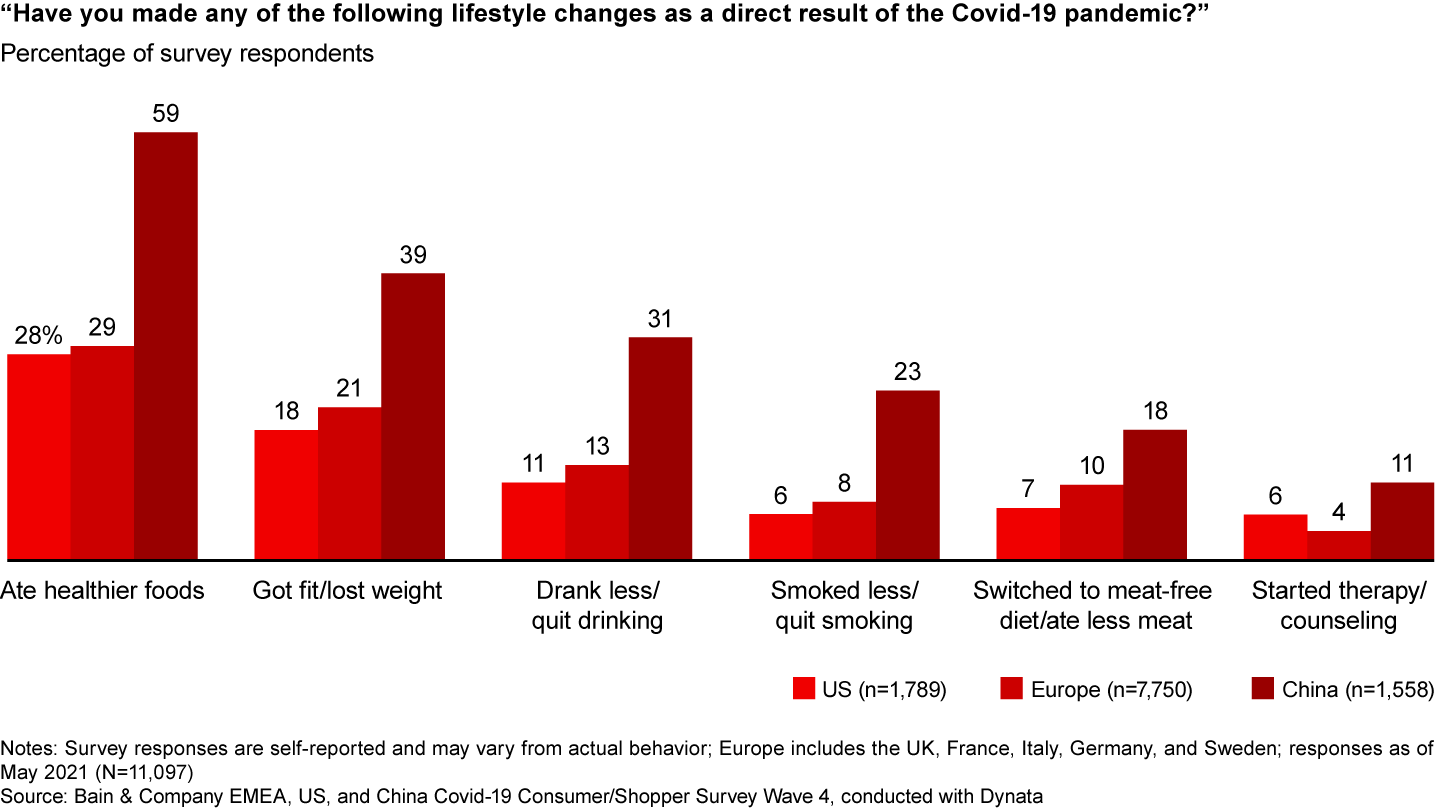
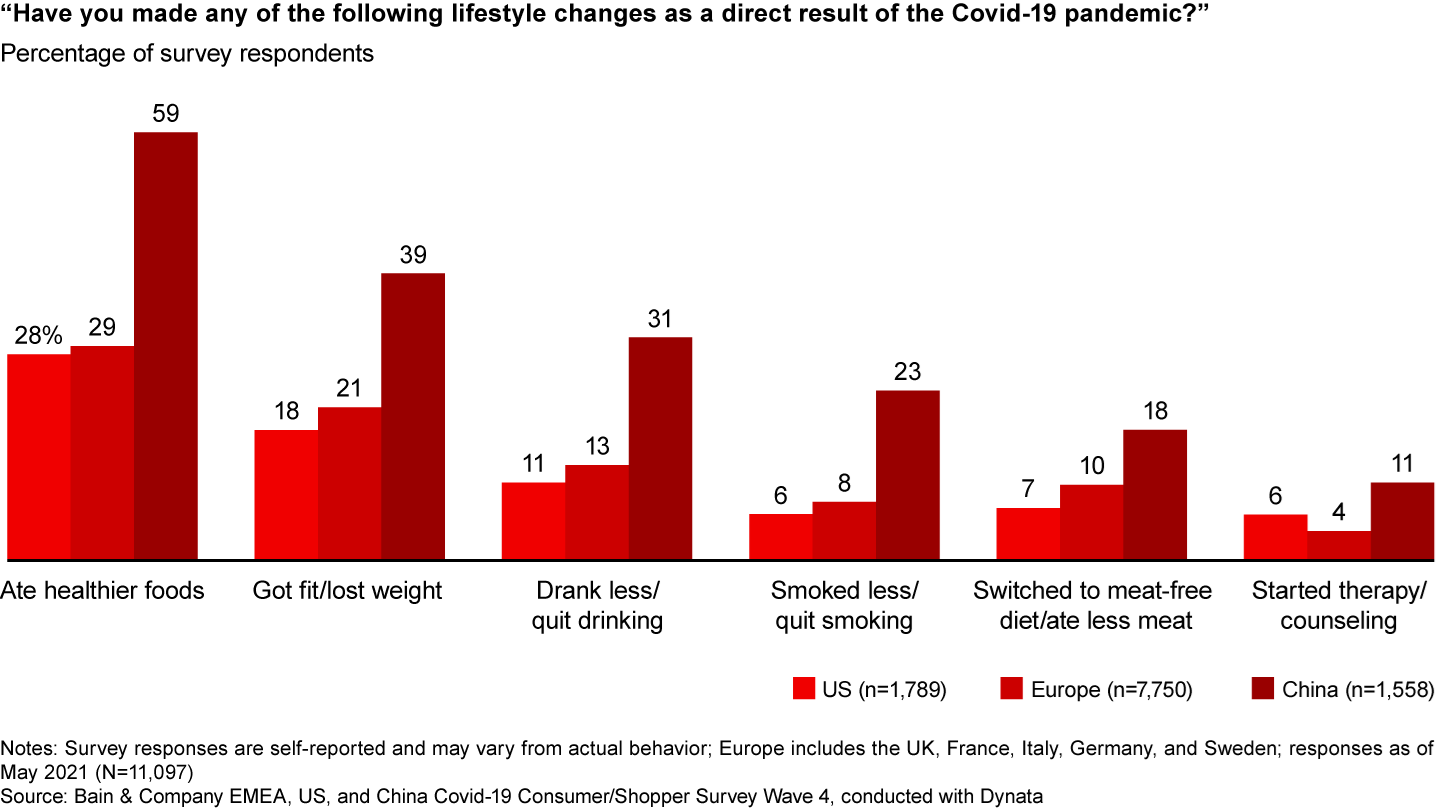
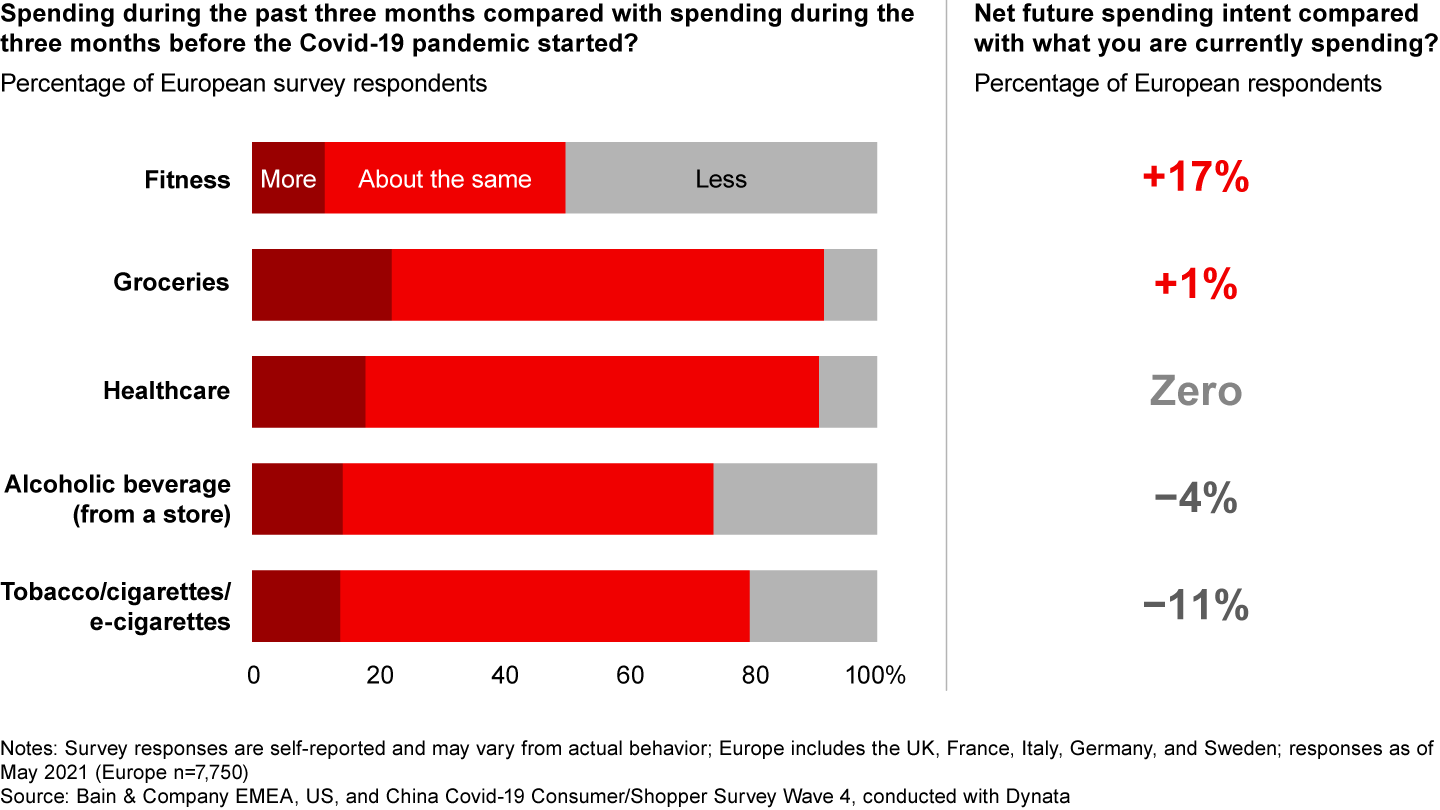
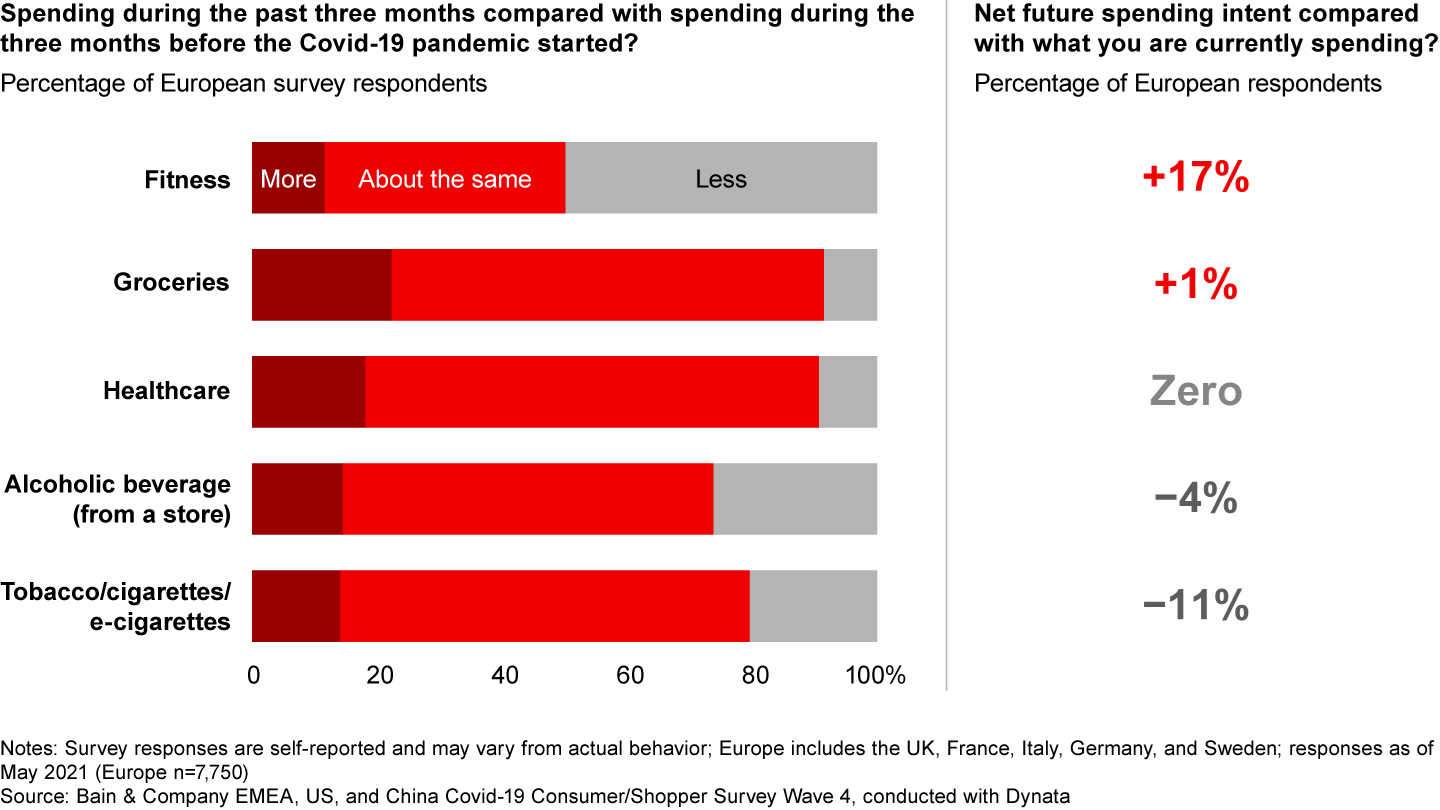
The pandemic has also inspired greater focus on personal hygiene. According to a report by J.P. Morgan Research, Henkel (the parent company of brands such as Persil and Schwarzkopf) saw US hand soap sales jump by around 60% during the first half of 2020, with continued demand into the third quarter, when sales rose by 33%. In October, sales grew by more than 23%.
Consumer demand for healthy products is rapidly rising, and the 2021 Bain survey showed that the focus on health will persist beyond the pandemic (see Figure 5). For example, the global vitamins, minerals, and supplements market is expected to grow annually by 11.7%, to become a $365 billion in revenue business by 2030.
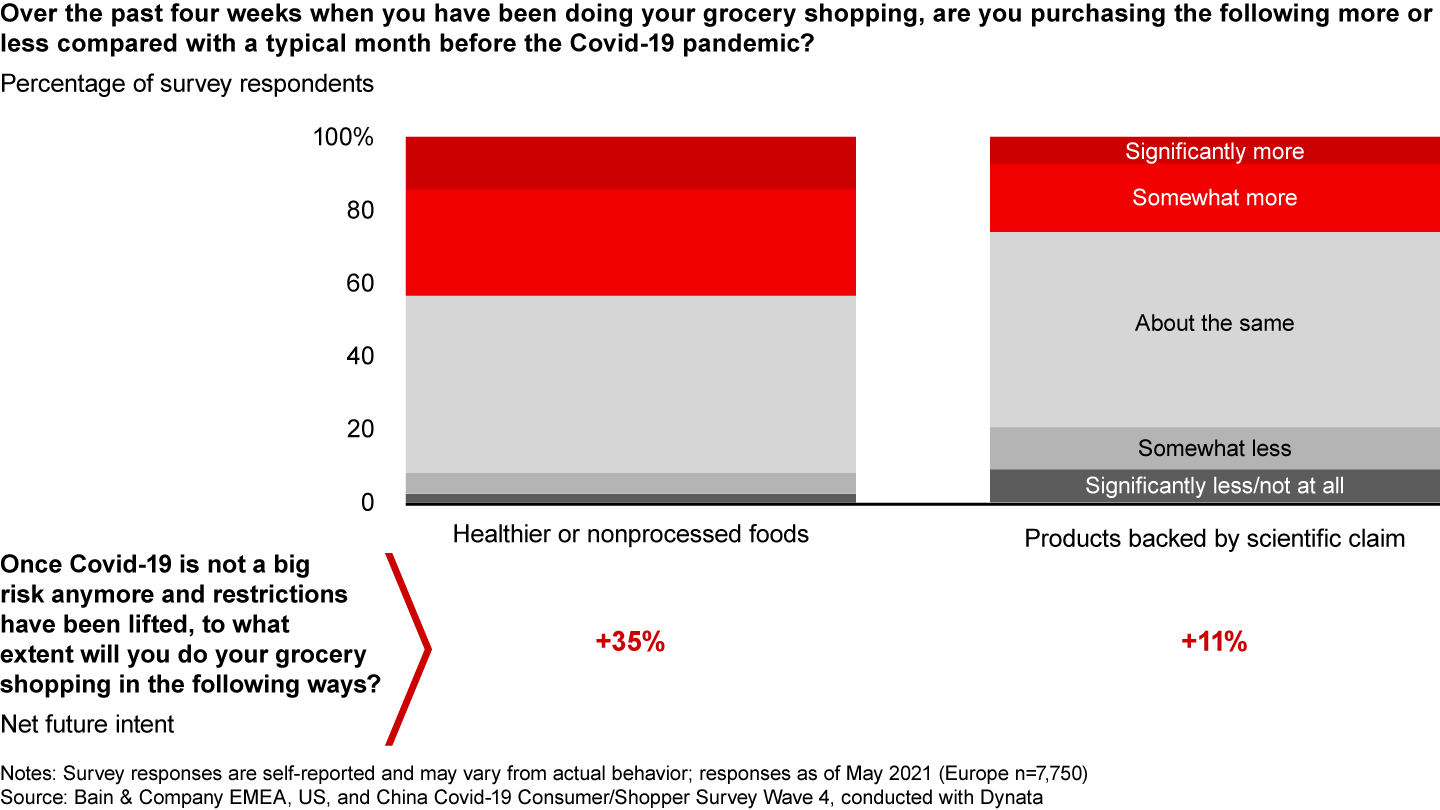
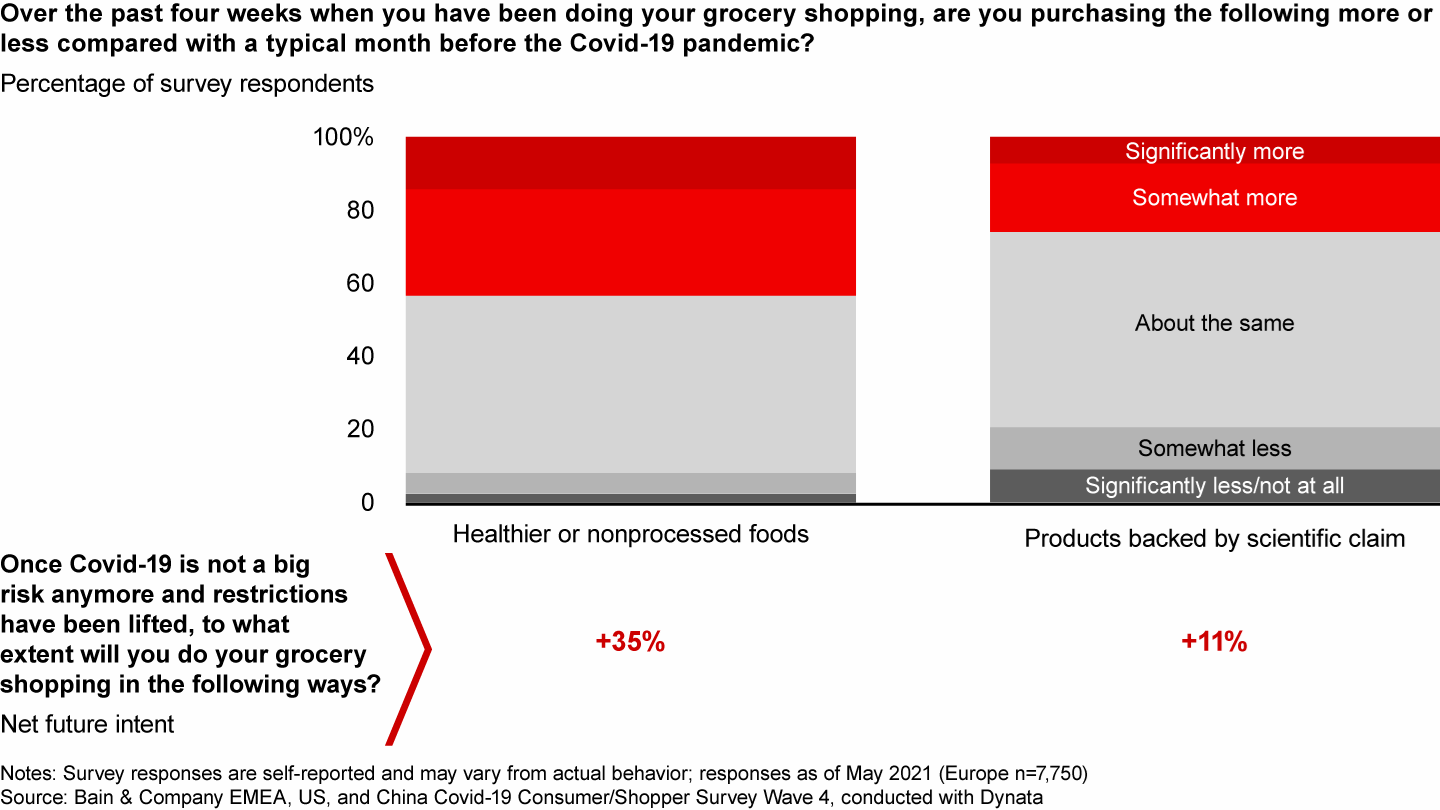
The rising health consciousness is supported by regulatory intervention, particularly in food categories (see Figure 6). For example, Chile launched its Law of Food Labeling and Advertising in 2016, which mandated front-of-package (FOP) warning labels, among other moves (see Figure 7). Because of the remarkable impact on consumer purchasing behavior, Chile subsequently tightened its FOP requirements. In the UK, following the prime minister’s own personal battle with Covid-19, the country also committed to a series of new legislation to tackle its obesity crisis. All told, more than 600 million people live in countries with taxes on added sugars (see Figure 8).
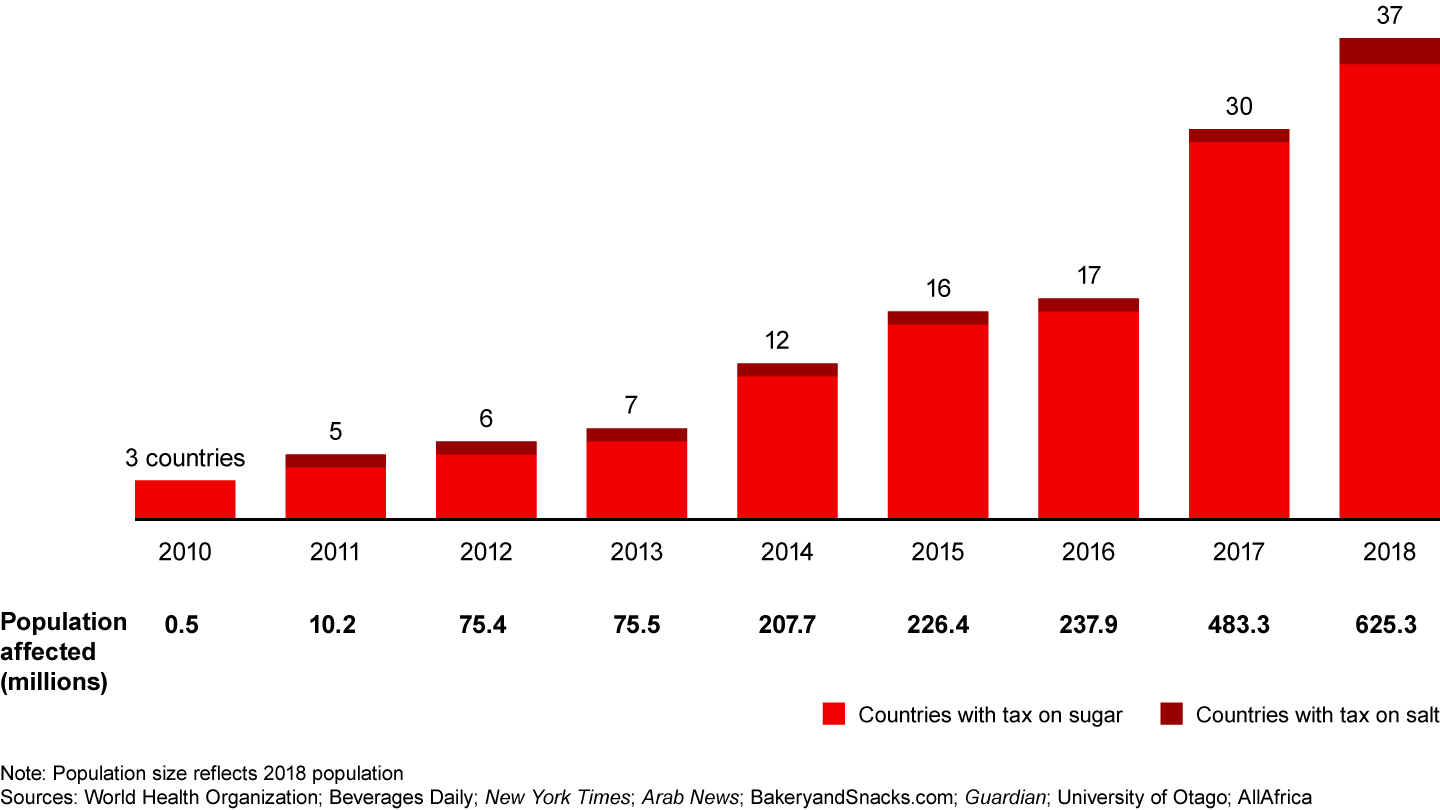
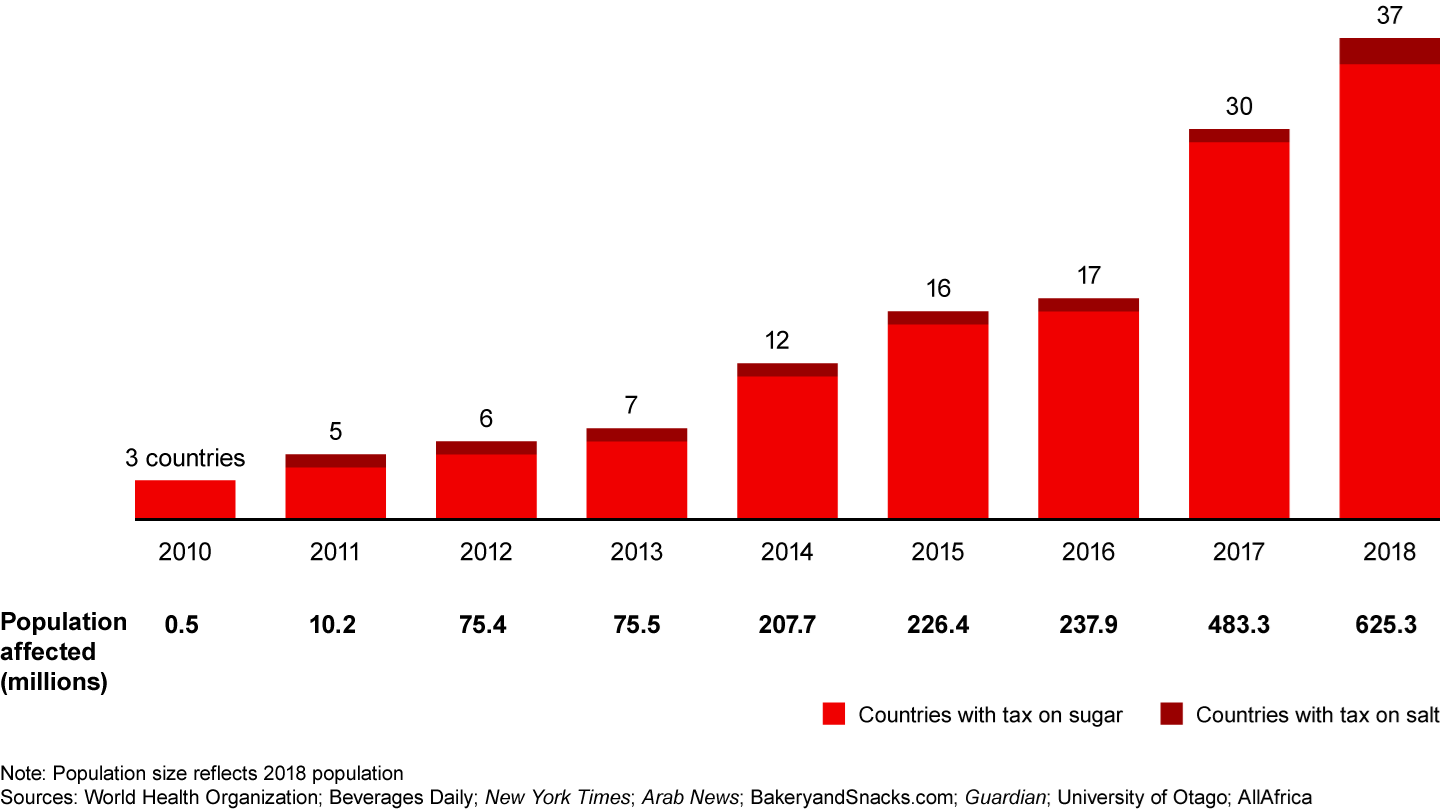
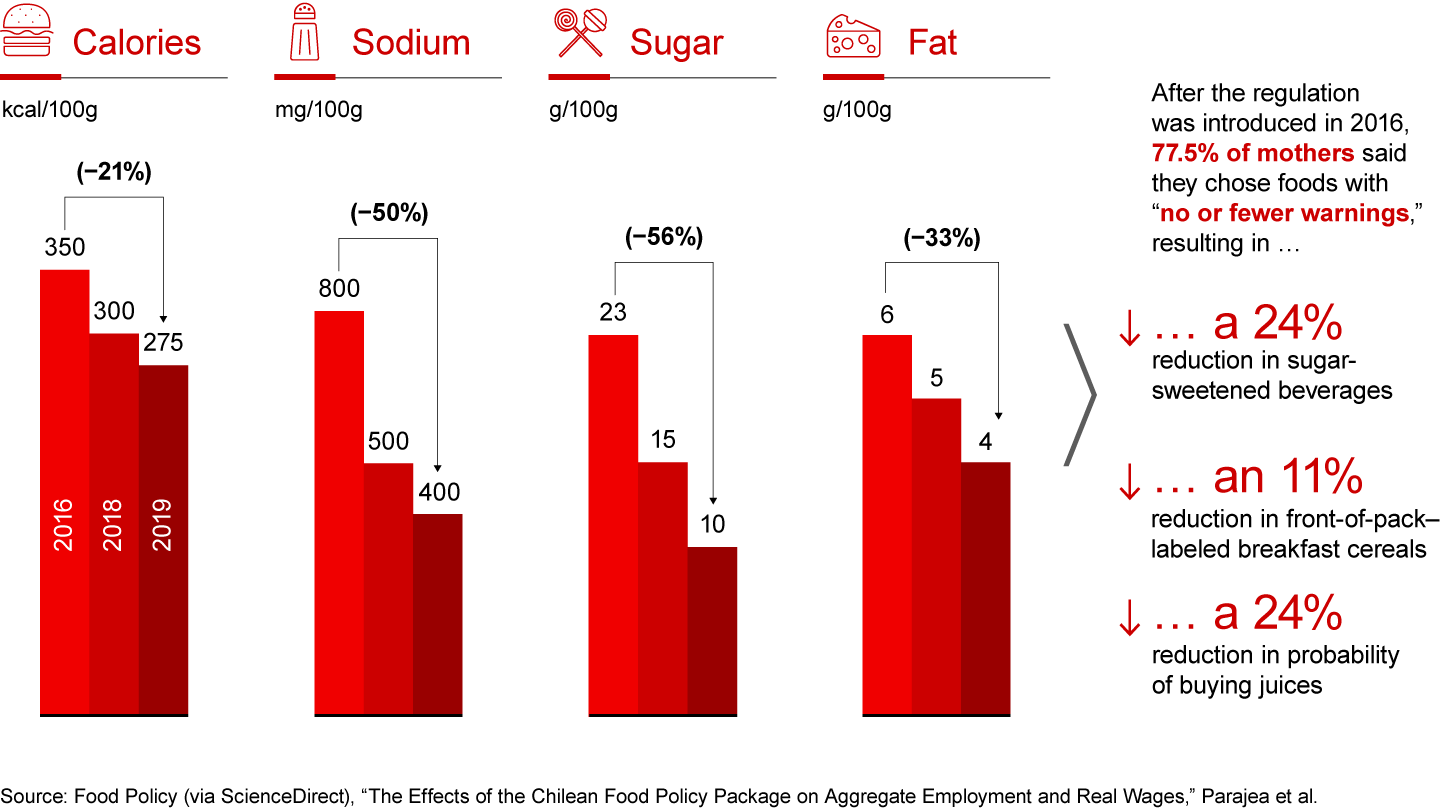
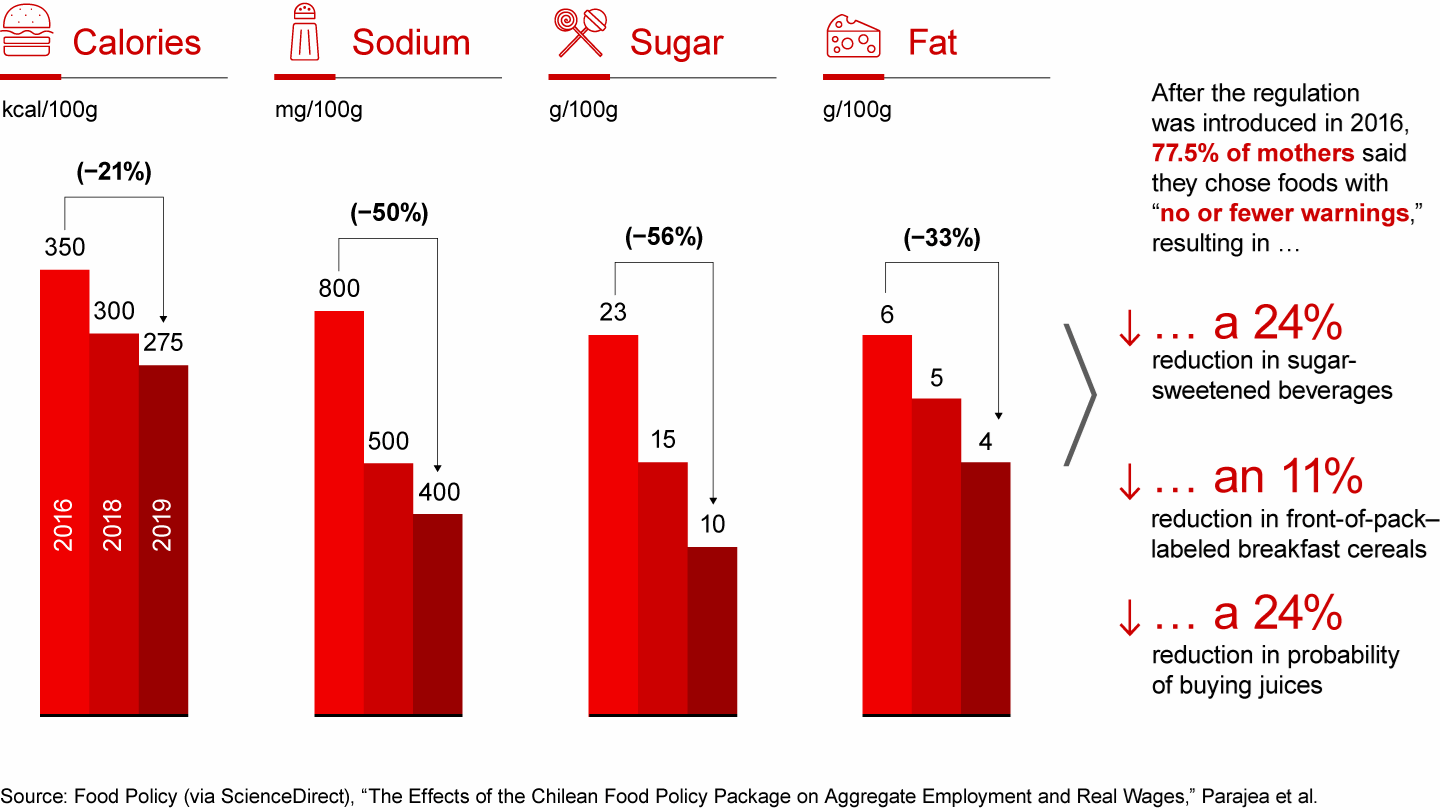
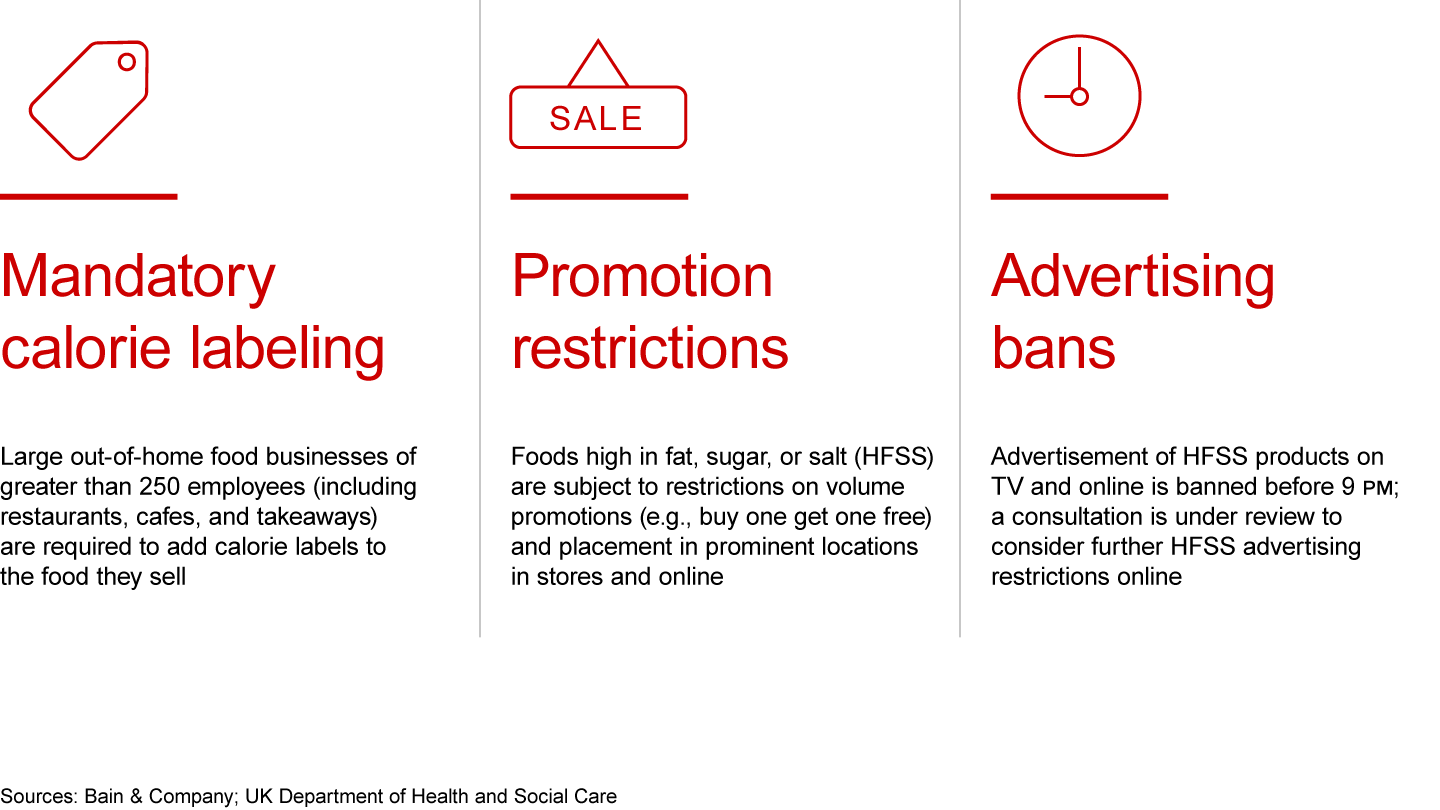
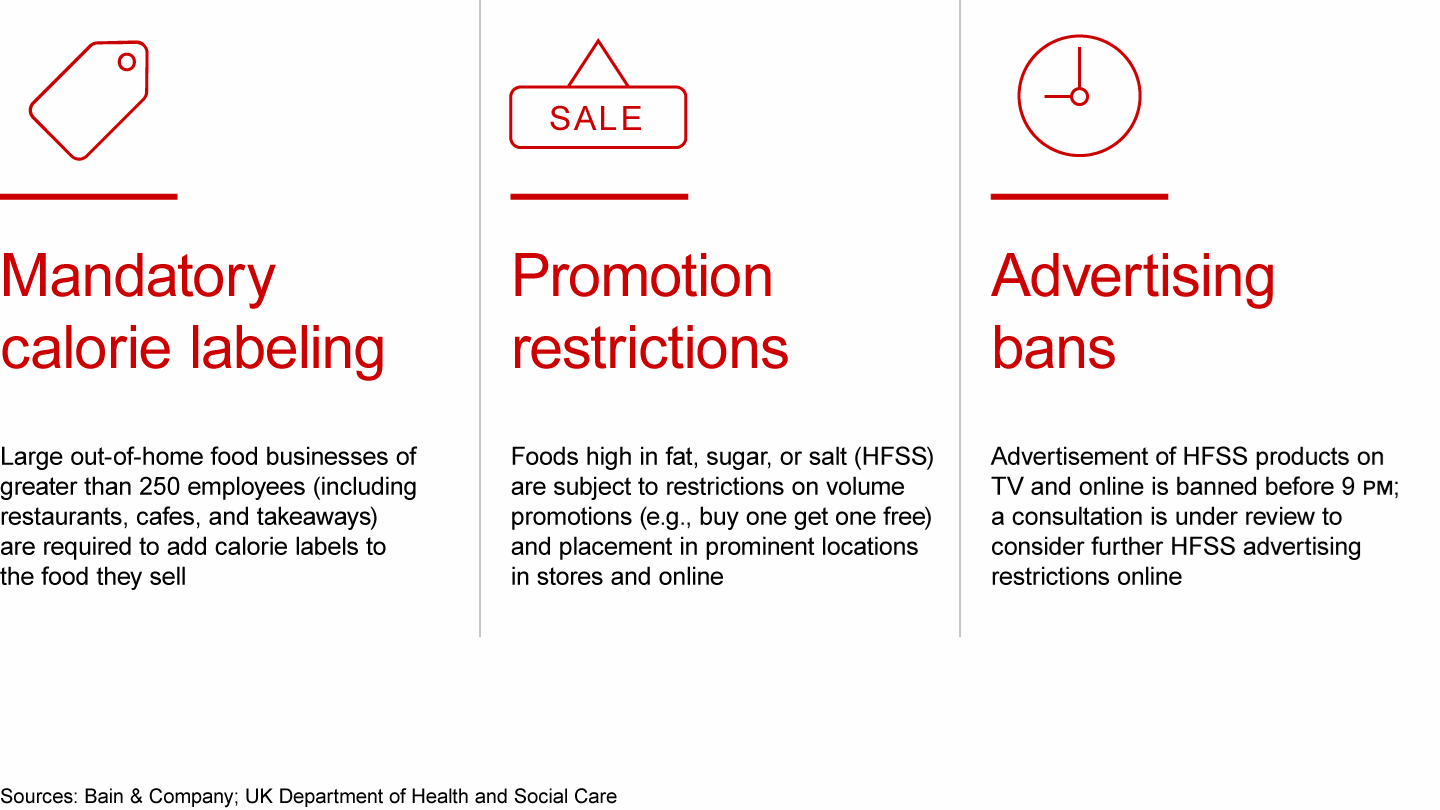
Such regulation can pose an existential threat for select manufacturers and retailers.
When players proactively evolve their portfolios, however, there can be a positive impact on healthier consumption without any detriment to the category.
In the following chapters, we will examine consumer health programs conducted by brands and retailers around the world, assess the factors that contribute to success, and offer insights into the best ways to scale programs to multiply benefits.
Ambitious and varied programs to date
The CGF, a CEO-led global network of some 400 retailers, manufacturers, and other industry stakeholders, formed CHL, a coalition led by manufacturers and retailers, working in collaboration with public health authorities, local communities, and academic institutions, to help its members lead the way in empowering global consumers to achieve healthier living.
Over the past three years, CHL launched 71 local programs (including more than 800 interventions, reaching more than an estimated 2.6 billion consumers, based on an internal assessment, and getting more than 50 million consumers to purchase a healthier product or service promoted via CHL). Those programs were launched in the US, Mexico, Costa Rica, El Salvador, Honduras, Guatemala, Nicaragua, Colombia, France, the UK, Turkey, Japan, and China—with the recent addition of Russia (see Figure 9).
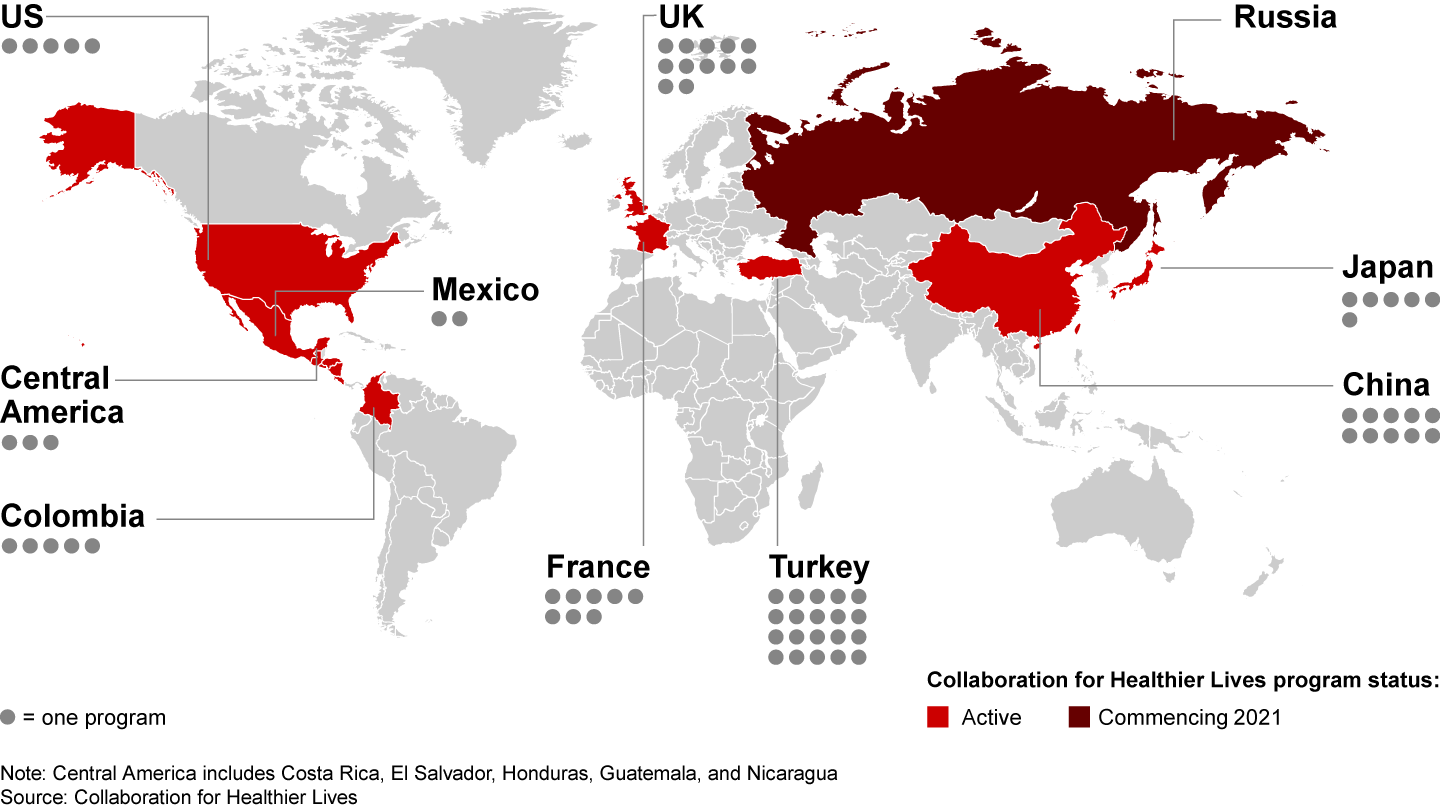
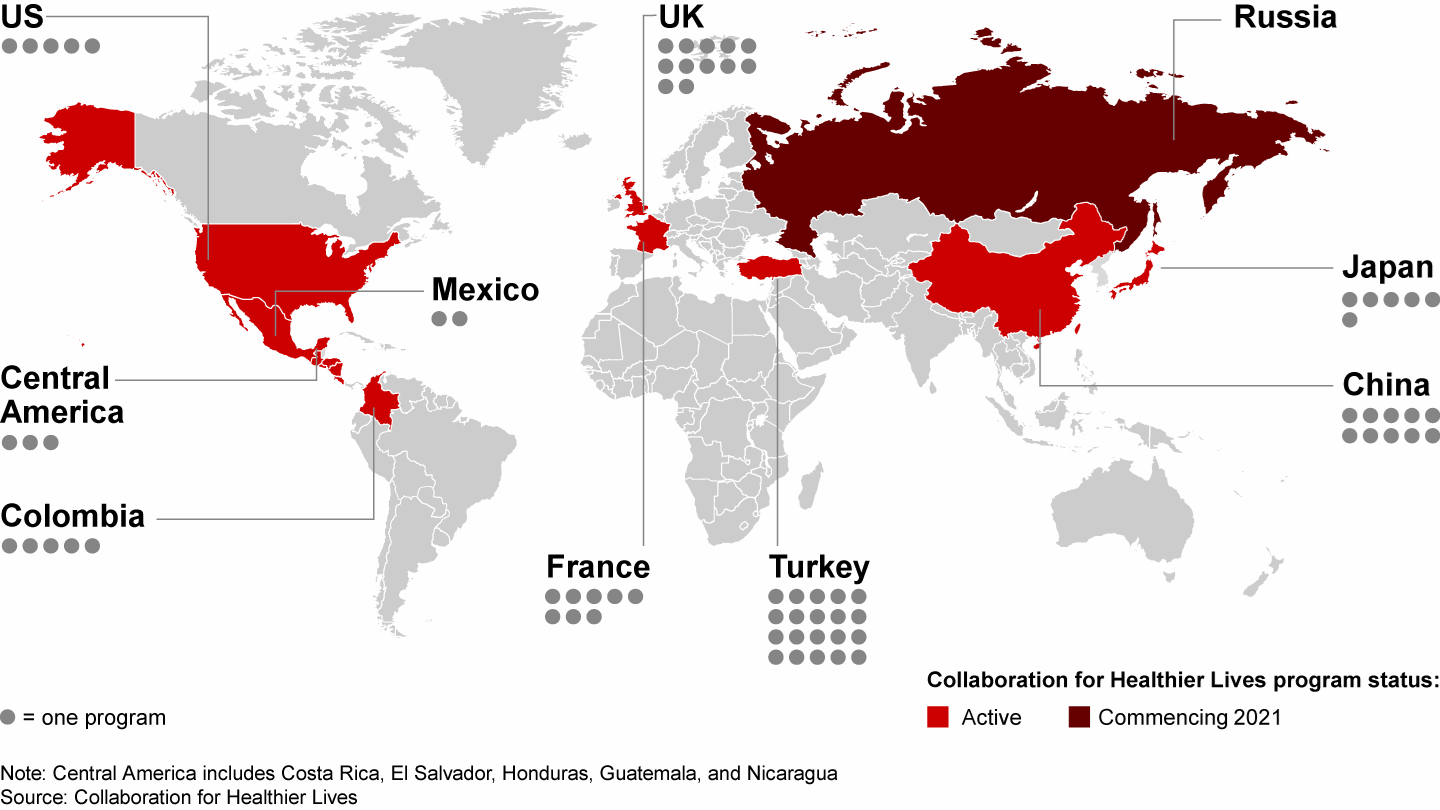
More than half of these programs solely involved food-based categories, and split between physical and digital channels, the programs focused on either building consumer awareness for health-related topics or altering purchasing behavior through changes in the shopping environment, such as pricing and promotions or modifications to product range and availability. Programs ran the gamut from health fairs to online apps that measure the healthiness of a basket and make personalized recommendations to skew the basket to healthier options (see Figures 10 and 11).
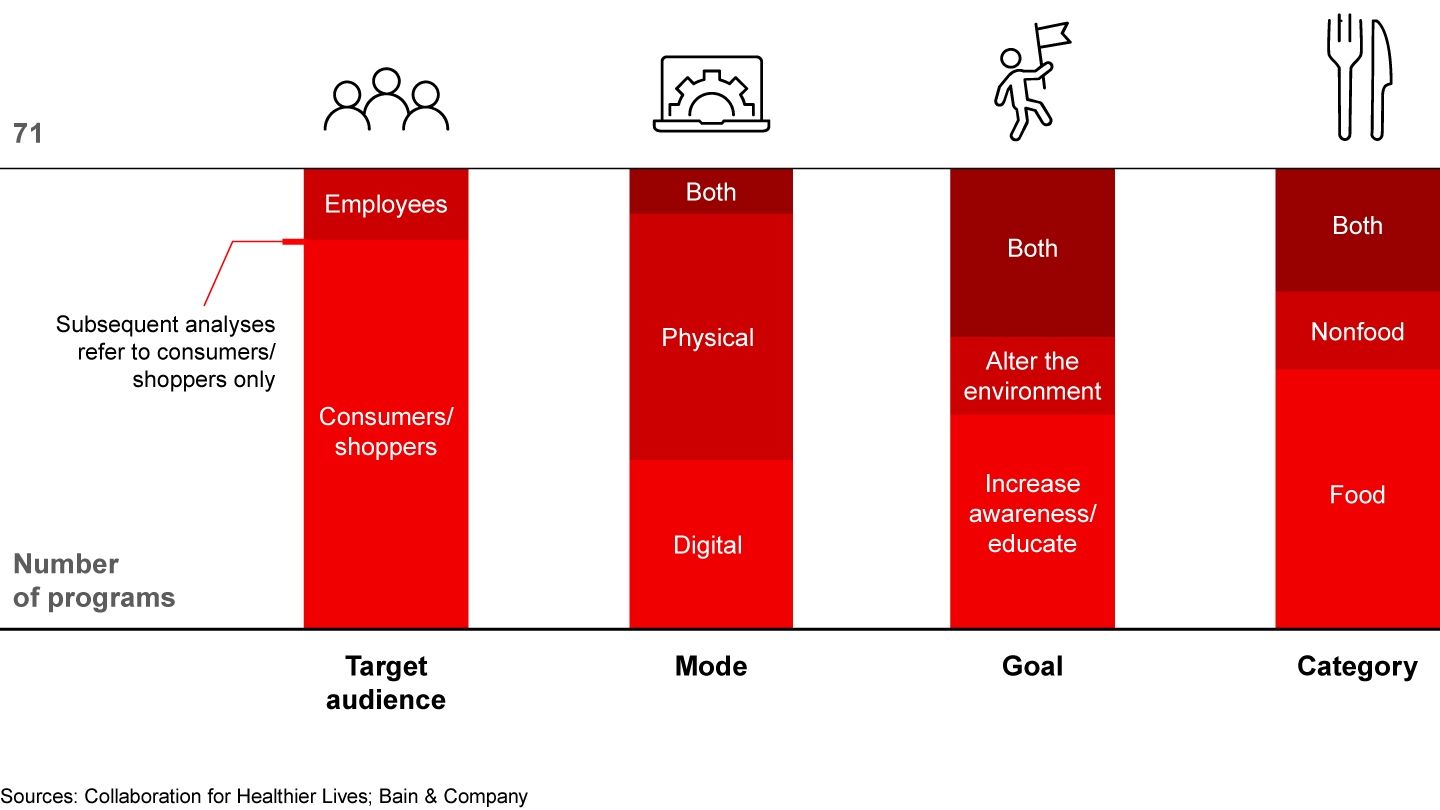
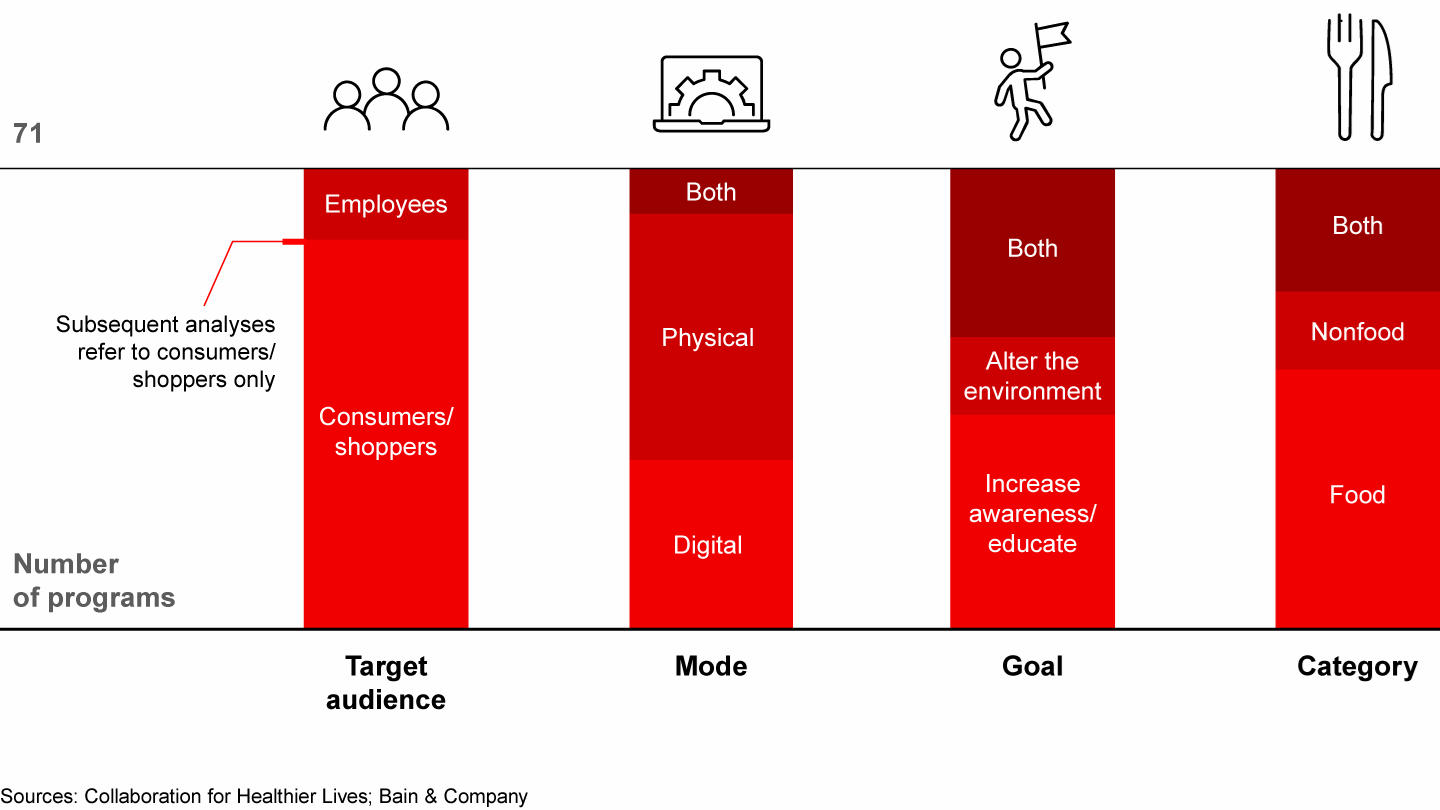
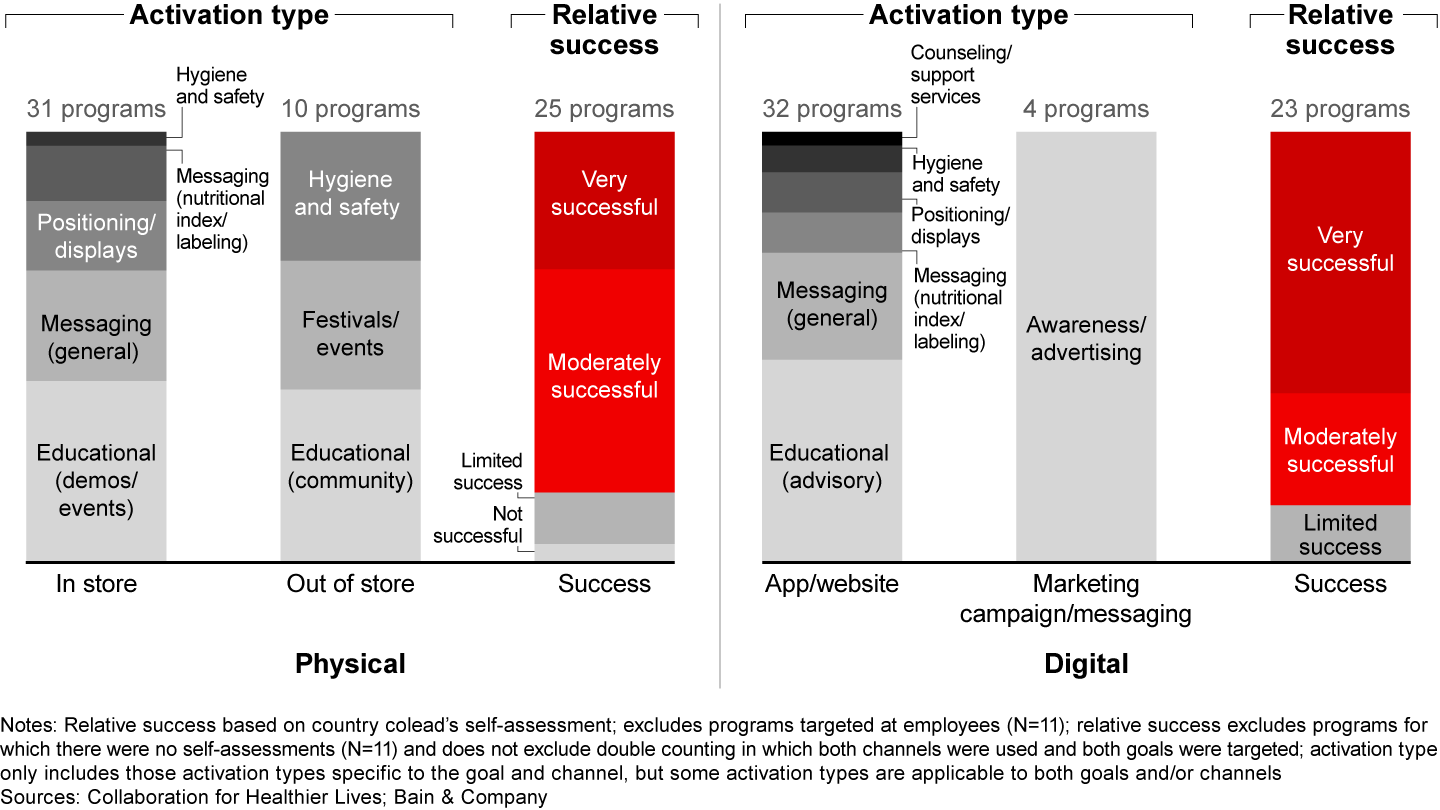
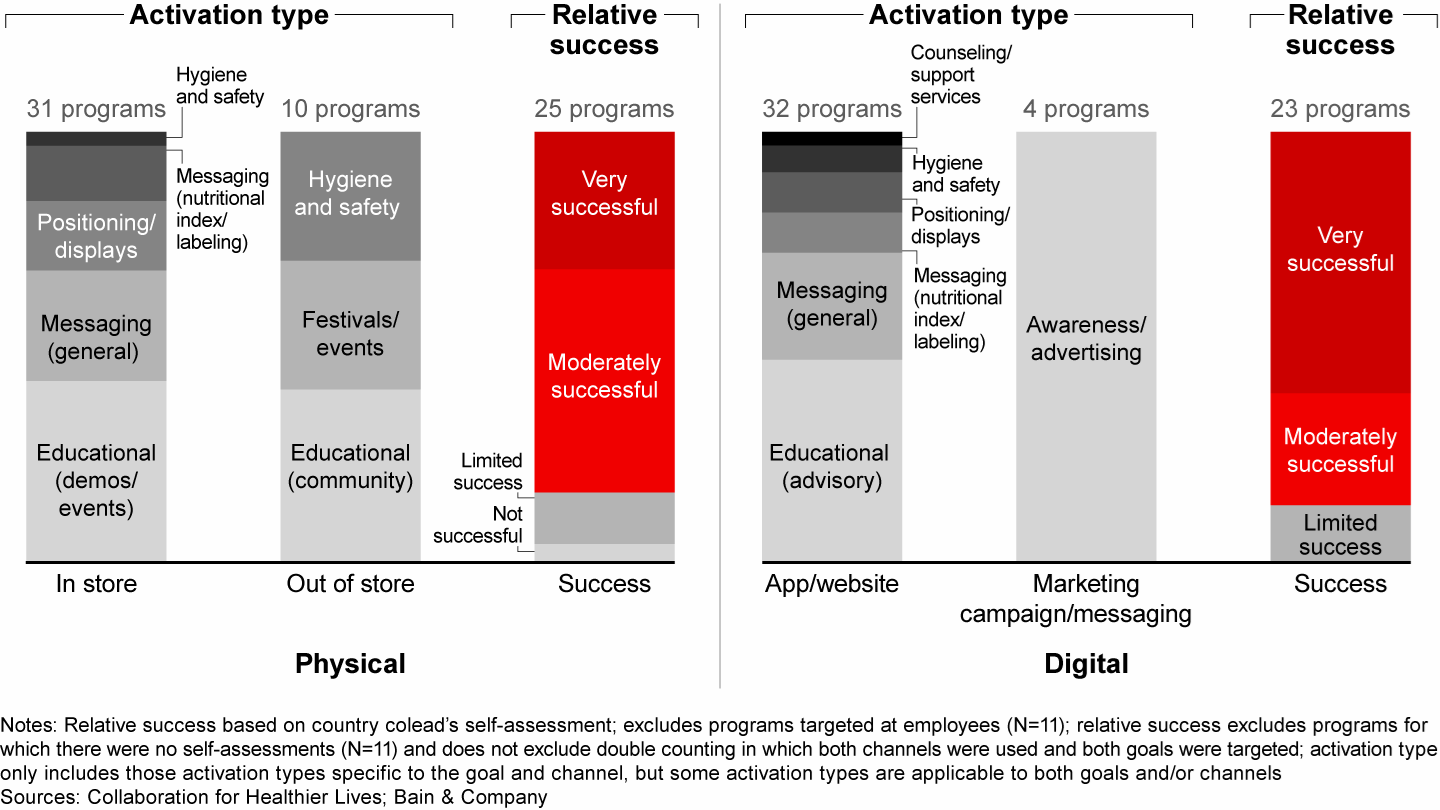
Almost half of the programs solely involved awareness or education. Among those efforts, advisory-based communication through apps, websites, and in-store demonstrations were the most common. For example, Suning Carrefour offered livestreams with nutritionists as part of CHL in China. Through CHL in Colombia, Grupo Éxito and Cencosud held in-store demonstrations by personal trainers and nutritionists, and as part of CHL in Mexico, Walmart and all manufacturers participating in Mexico Ponte Bien held in-store demonstrations in 10 Walmart stores of daily oral care, nutrition, and physical activity routines. Through CHL in the UK, Boots and GSK Consumer Healthcare ran in-store oral care events during the UK’s National Smile month.
Education and awareness programs were relatively easy to implement, according to Bain’s survey of program organizers, with the majority reporting that organizational buy-in was easy to obtain. Self-evaluation of programs by participating companies found that 86% of education and awareness programs were at least “somewhat successful” (of which 43% were rated “very successful”).
Academic research, however, shows that education and awareness programs are much less effective for creating lasting consumer behavioral change than programs designed to alter the shopping environment through means such as product availability or reformulation. Indeed, 96% of CHL shopping environment programs were rated at least “moderately successful,” but companies found such programs more challenging and labor intensive.
Academic research has determined that portion-size reduction and complete reformulation are the most effective tactics for consumer behavioral change. None of the CHL programs focused on portion size, however, and one involved reformulated products that fully replaced less healthy products. This was Freshippo and RT-Mart’s launch of healthier (reduced sugar, antibiotic free, hormone free, pesticide free) own-brand products in China. The original products were only fully replaced in some instances, however, while in other instances, the product options were displayed side by side.
Pricing and promotions were the most common activation levers, followed by product positioning changes. For example, with CHL in France, Carrefour and participating manufacturers introduced a special promotional price of 15% to 25% off almost all products listed on its “On s’y met” web page on Carrefour.fr. Similarly, as part of CHL in Turkey, Danone’s Activia smoothies were bundled with sandwiches at Migros Ticaret gas station stores in its Drive Well campaign. Migros Ticaret also partnered with Johnson & Johnson, Aptamil (Danone), and GSK (Corega) for baby skin care, baby nutrition, and denture care special offers, respectively. PepsiCo and Martin’s, a US grocer, collaborated to change product positioning by displaying “better for you” products in prominent store spaces selected by their Guiding Stars program nutritional rating. Tesco removed the promotional display units for Easter confectionary in 35 intervention stores over a three-week period. Chocolate sales increased by less than a third in those stores compared with the control group.
Only three of the programs involved changes to product availability or range, including McCain’s introduction of a new range of frozen baked French fries with a lower fat content alongside standard chips in 35 Tesco stores.
In general, digital activations were self-rated by participating companies as being the most successful—they feel they are targeted, allow for personalization, facilitate data collection, enable learning loops, and are more easily scalable. Digital programs were typically less challenging to implement, too. They required less expense, labor, and time (see Figures 12, 13, and 14).
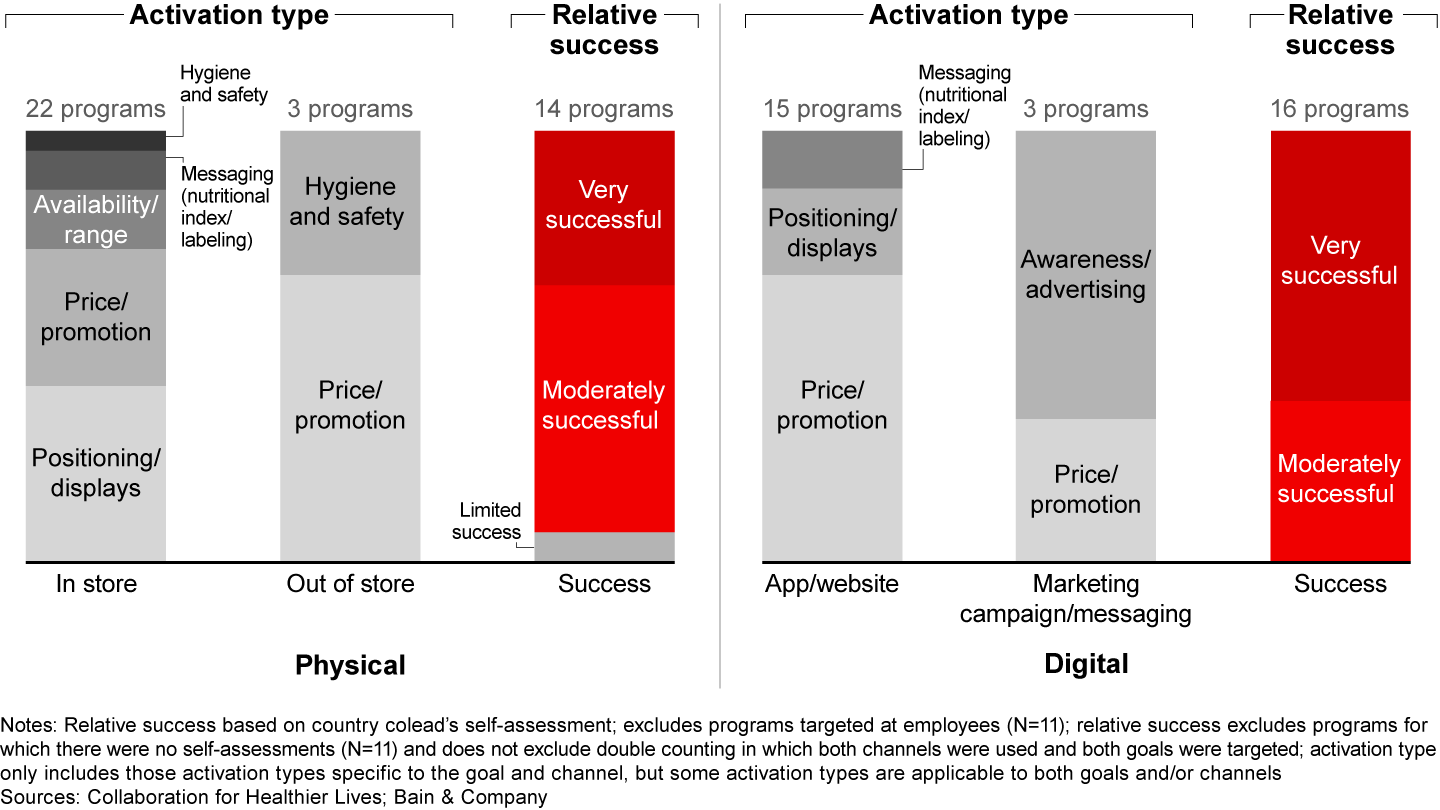
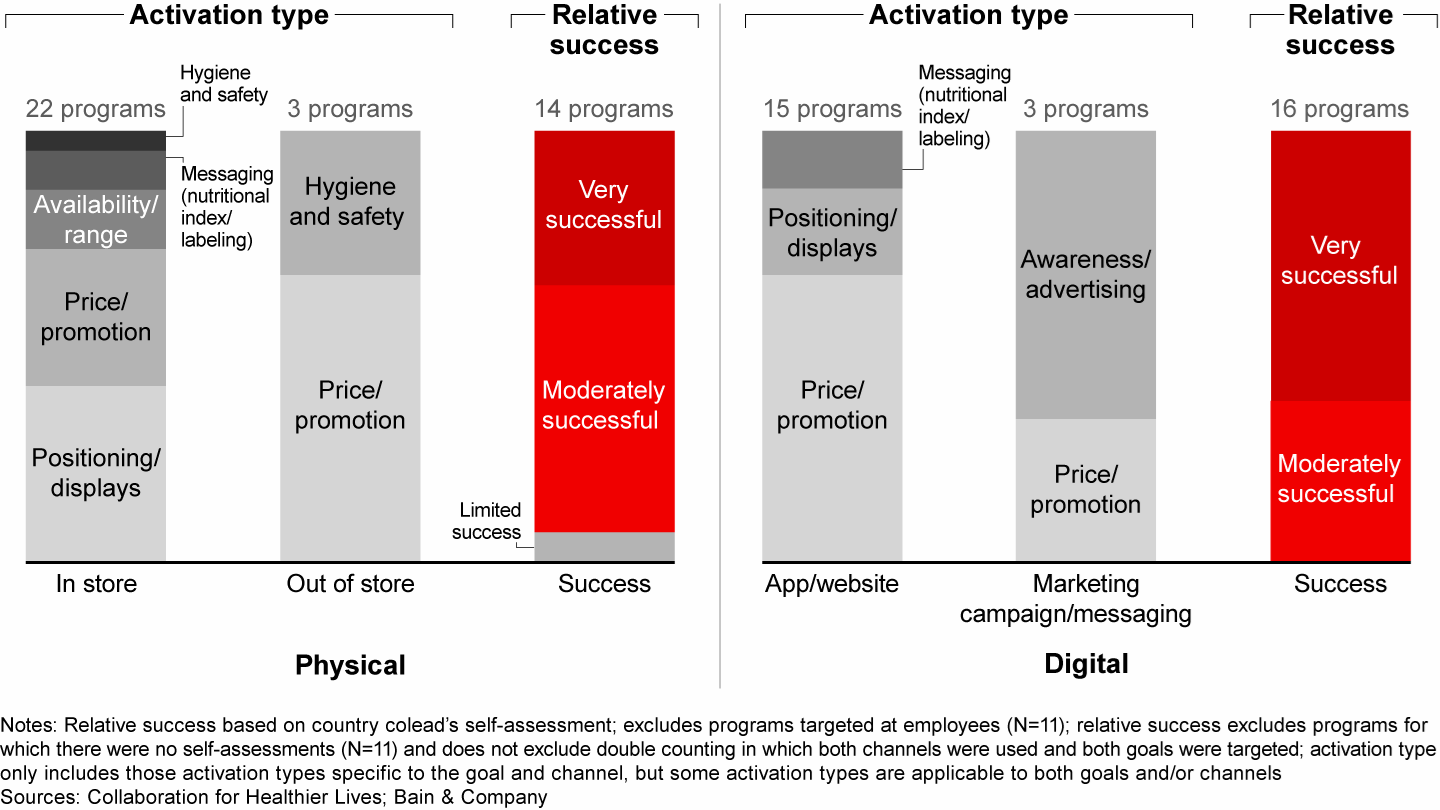
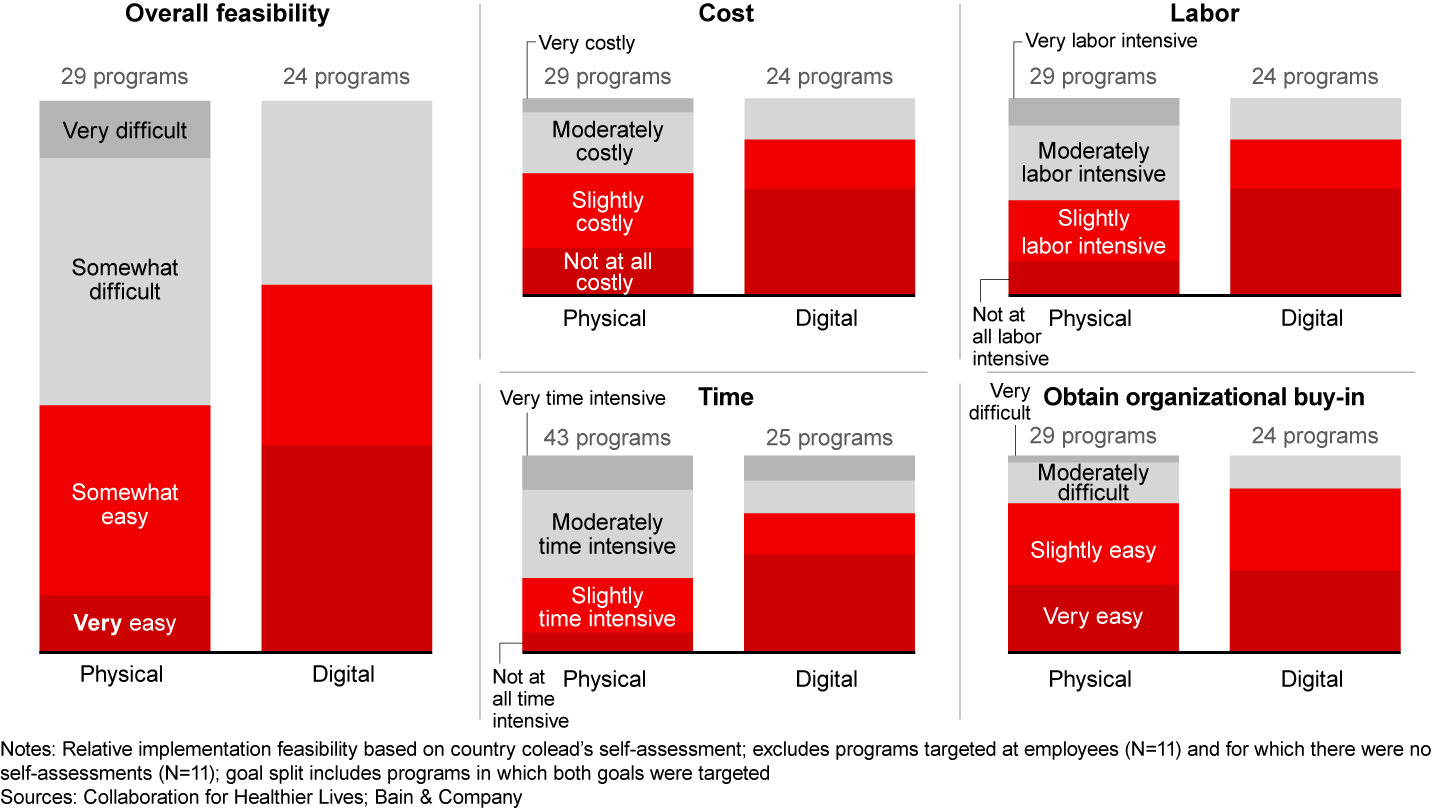
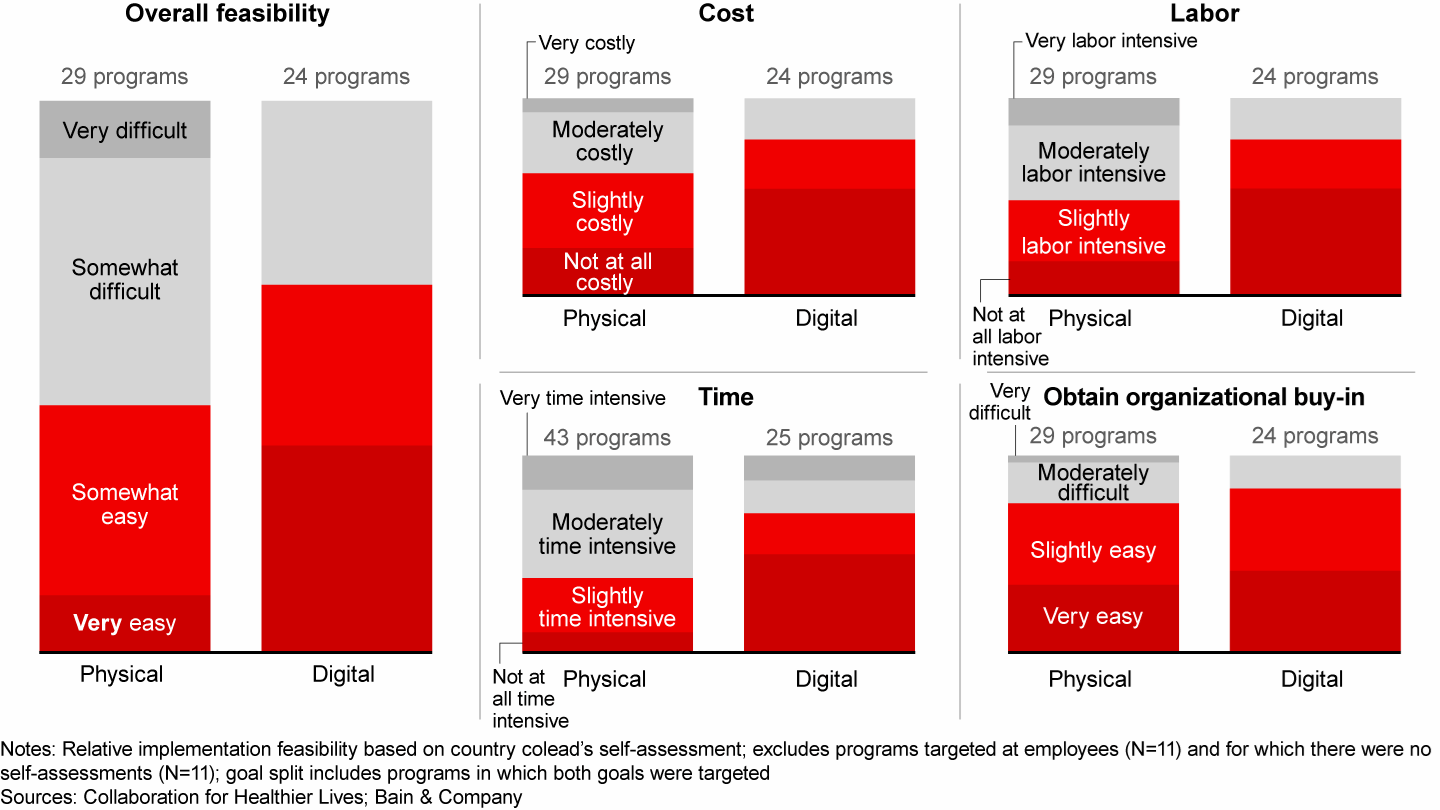
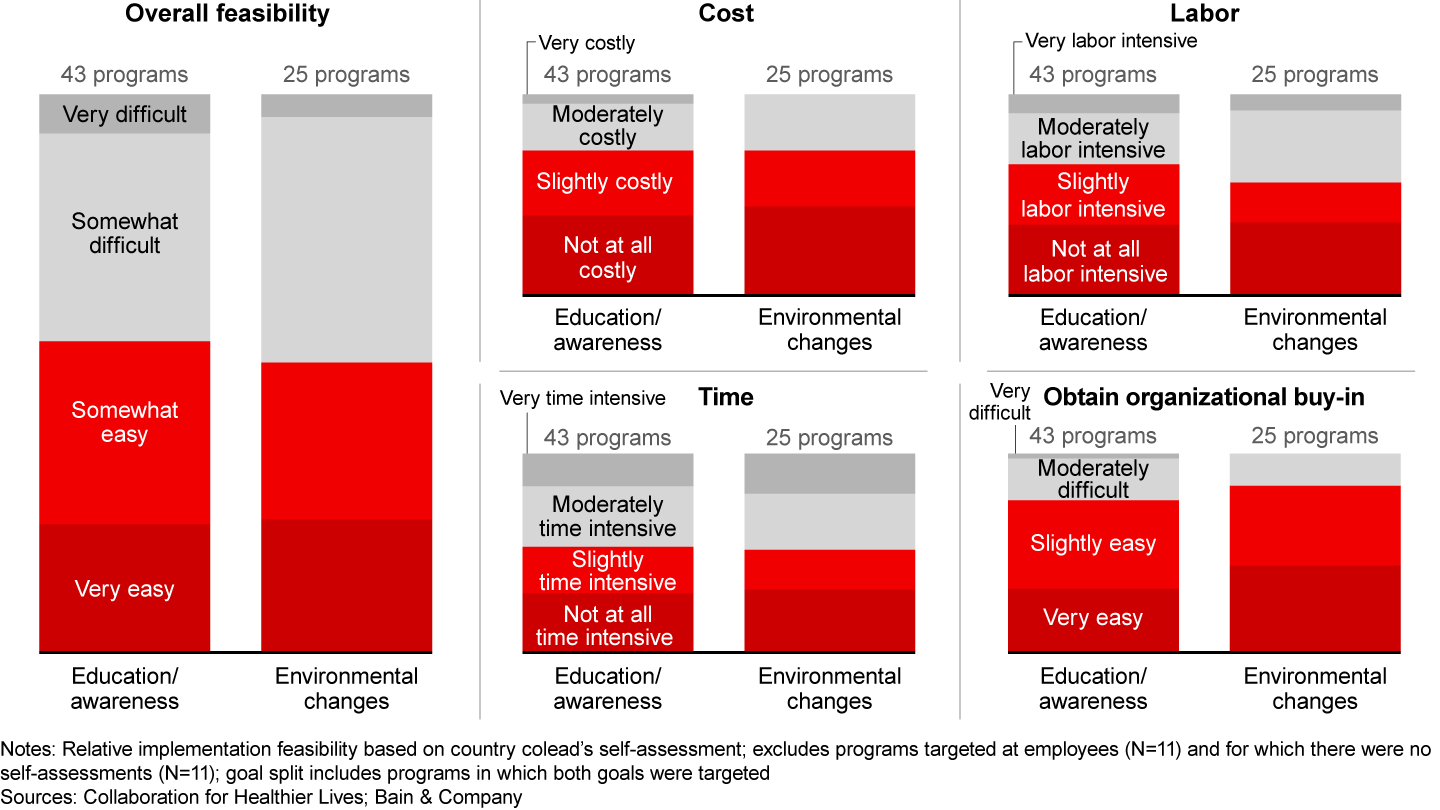
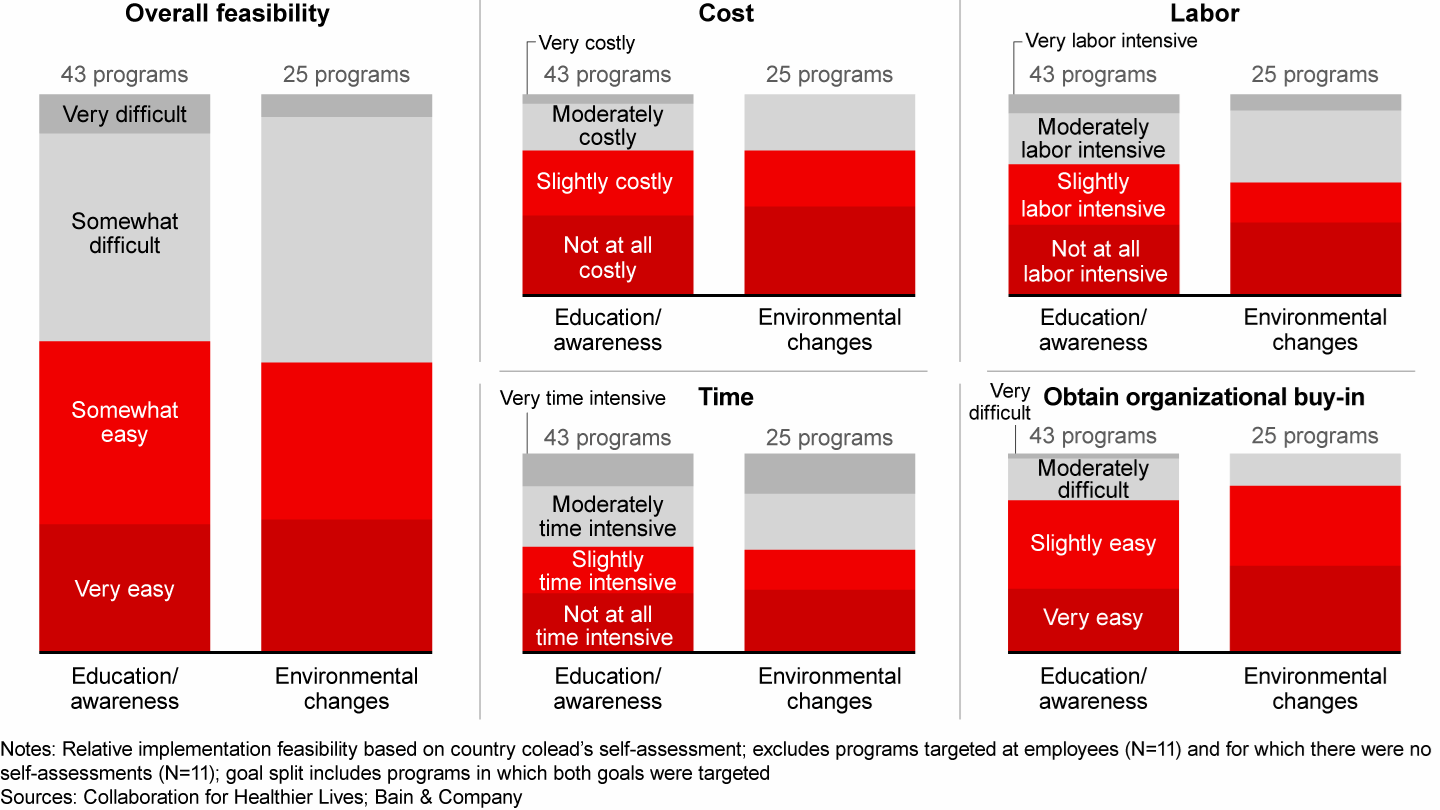
When it works—what we have learned
Participating companies’ self-assessments combined with academic research helped us identify four success factors for local healthy living programs (see Figure 15).
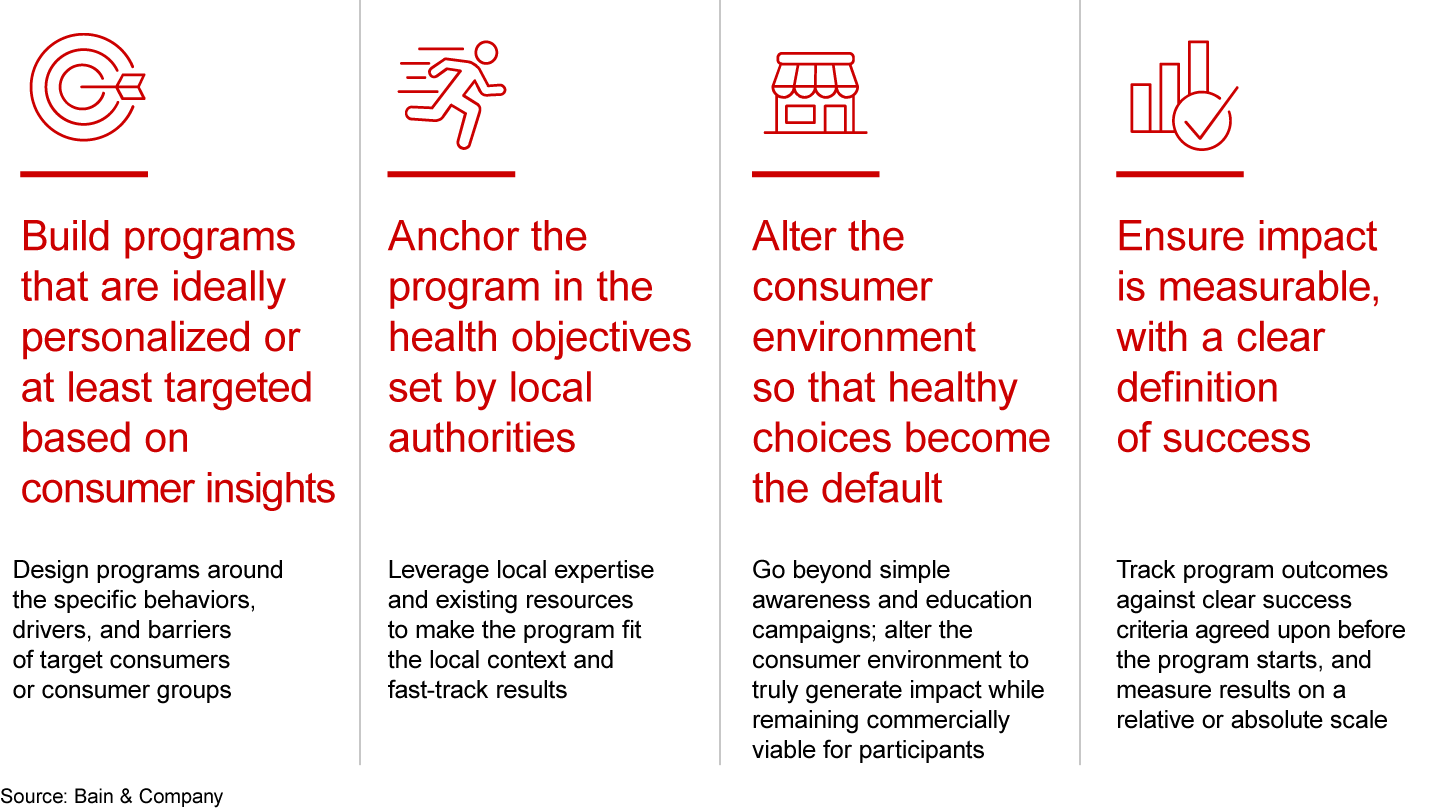
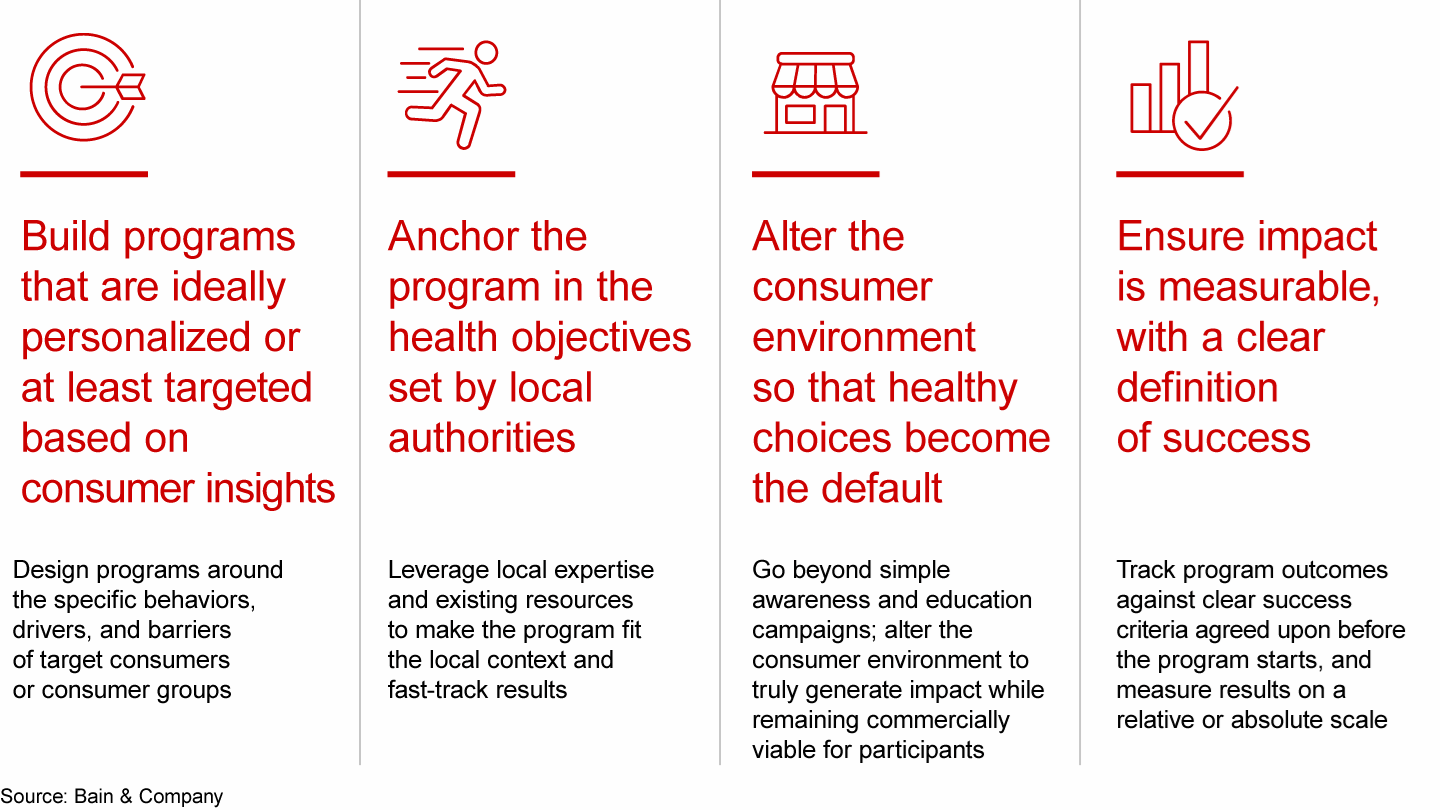
Build programs that are personalized or at least targeted or segmented based on deep, actionable consumer insights. Programs should be rooted in behavioral science and real consumer insights to better target the specific contributors to healthy behavior and overcome the most relevant barriers for target segments.
For example, within CHL in the UK, ethnographic research conducted by Guy’s and St. Thomas’ Charity determined that price was a key barrier to healthy eating among the pilot population residing in the London boroughs of Lambeth and Southwark. Acting on that insight, Tesco UK launched a local, targeted pricing promotion. Its “Fresh 3” program rotated three different packs of fresh fruit or vegetables on special offer every two weeks, resulting in a double-digit increase in sales vs. the previous year when compared with control stores. Following this success, the local program rolled out to Tesco Express stores.
Through CHL in Turkey, Migros Ticaret developed the WellBeing Journey section within its mobile app, allowing consumers to visually compare the Turkish Ministry of Health’s recommended daily calorie distribution per food group with their own individual shopping basket. This helps consumers clearly see which food groups they are lacking and sends them special offers on products tailored to their individual nutritional needs.
Outside of CHL programs, there are other examples of how deep behavioral insight can be harnessed to better-targeted efforts.
In partnership with Bain & Company and others, the World Business Council for Sustainable Development defined different ethnographic consumer segments in the UK (e.g., “food rich, time poor”; “snack pack”; “health poor”; etc.) and identified the most important factors influencing diet—and barriers to adopting healthier food choices. This approach enables retailers and manufacturers to target their marketing for different consumer types.
Whisk, an AI-powered recipe and meal-planning app, allows users to organize recipes, generate shopping lists from recipe ingredients, and order directly from online grocery delivery partners, including Walmart, Amazon, and Instacart. By streamlining the convenience of purchasing, the app helps consumers who are tech-savvy and food-rich, but time-poor, overcome one of the key barriers to healthy living.
Going one step further, Noom is a health app designed by behavioral psychologists, nutritionists, and personal trainers to help consumers make tangible and sustainable lifestyle shifts that are customized for the individual user. The app integrates user-specific data such as personal demographics, health status, and lifestyle goals together with daily lifestyle data (e.g., scanning food barcodes) to create a personalized user experience, resulting in significant sustained weight loss in 78% of users.
Anchor the program in locally relevant health objectives, and leverage resources from elsewhere when practical. Adopt work conducted or vetted by other relevant stakeholders to benefit from previous experience and move into action quickly, especially when it relates to local contexts or specific goals. This could mean aligning with health goals set by local authorities or implementing programs with demonstrated results elsewhere. Consider how with CHL in Turkey, existing local resources helped Migros Ticaret get up to speed in setting up its program. The Turkish Ministry of Health endorsed the program, bolstering its credibility, and allowed Migros Ticaret to use and reference its resources on balanced nutrition. The company also worked with the Anadolu Medical Centre to establish the ideal consumption for balanced nutrition for vegans and vegetarians and with the Turkish Dental Association to focus on oral and dental care. Similarly, CHL in China based its work on the 15 special campaigns published in the Chinese State Council’s “Healthy China 2030” program, which focus on disease prevention and health promotion. Meanwhile, CHL in Central America used marketing and promotional materials from Colombia’s “Ser Saludable Se Siente Bien” (“It Feels Good to Be Healthy”) campaign to quickly move to action.
Programs must also be adapted to the local context. In the US, CHL worked with Healthy Washington County to identify four pillars for improving health and well-being that are particularly relevant in that target community: healthier food choices, exercise, smoking cessation, and medication adherence. Given differences in population demographics, CHL in Japan focused on the elderly by promoting healthier lifestyle habits that extend life expectancy, such as salt reduction.
Alter the consumer and shopper environment so that healthy choices become the default for consumers while remaining commercially viable for participating companies. Our findings suggest that consumers may still make unhealthy choices despite increased awareness and education. Ultimately, the environment and “nudging” cues exert a much stronger impact on what people do than what people consciously think. Therefore, there is a significant opportunity for manufacturers, retailers, and voluntary private sector members to look further upstream at environmental changes—everything from innovating healthier reformulations to making healthier options more readily available, prominent, or accessible through pricing.
When players proactively evolve their portfolio, there can be both a positive impact on healthier consumption and a commercial benefit to the category as a whole. For example, many leading brewers have extended their packaging lines to include smaller, more approachable can and bottle formats. Not only does this foster responsible drinking, but it also offers an opportunity to reach new consumers or drinking occasions and increases revenue per hectoliter.
Similarly, within CHL, when McCain introduced a new range of lower-fat frozen baked French fries in the UK, sales of its full-fat French fries fell by 19% while the lighter French fries saw an approximately equal uplift in sales. To deliver true, sustained outcomes on consumers, the less healthy SKUs should eventually be phased out.
Environmental changes have also been shown to influence a broader range of consumers, especially those in lower socioeconomic positions who suffer disproportionately with poorer nutrition and health outcomes.
Ensure the impact is measurable, with a clear definition of success. Companies need to devise ways to measure and track changing consumer behavior. Academia can bring legitimacy, but organizations must be willing to share high-quality data and engage academic partners early enough in the process.
In the UK, CHL partnered with the University of Oxford to help set up and independently evaluate its programs. Oxford received data for a number of the programs and prioritized the longer and more ambitious trials. In those instances, the assessment provided a clear indication of a program’s relative success and provided highly valuable insight into whether it should be scaled.
In Turkey, Migros Ticaret partnered with KPMG for measurement, methodology development, and reporting. Together they created the Balanced Nutrition Index to effectively show how close consumers' baskets are to ideal balanced nutrition. After receiving data directly from Migros Ticaret, KPMG was able to independently evaluate the program’s success.
In CHL France, Insead and Institut national de la recherche agronomique are independently measuring the nutritional evolution of the basket.
It is also critical to establish success metrics up front and give trials enough runway. In our assessment, many participants lacked a predetermined yardstick for what constitutes a successful program. CHL is currently in the process of developing a global key performance indicator framework to help define the right metrics, thresholds, and indicators of success to track and assess CHL programs.
The roadmap ahead—what it takes to scale and next steps for CHL
CHL has a bias for action, and its pilots are meaningful and exciting for participants. Unless programs can scale, however, they will have limited long-term impact. Building on work supported by the University of Oxford, we propose four ways to scale: expanding products, geographies, time period, and stakeholders (see Figure 16).
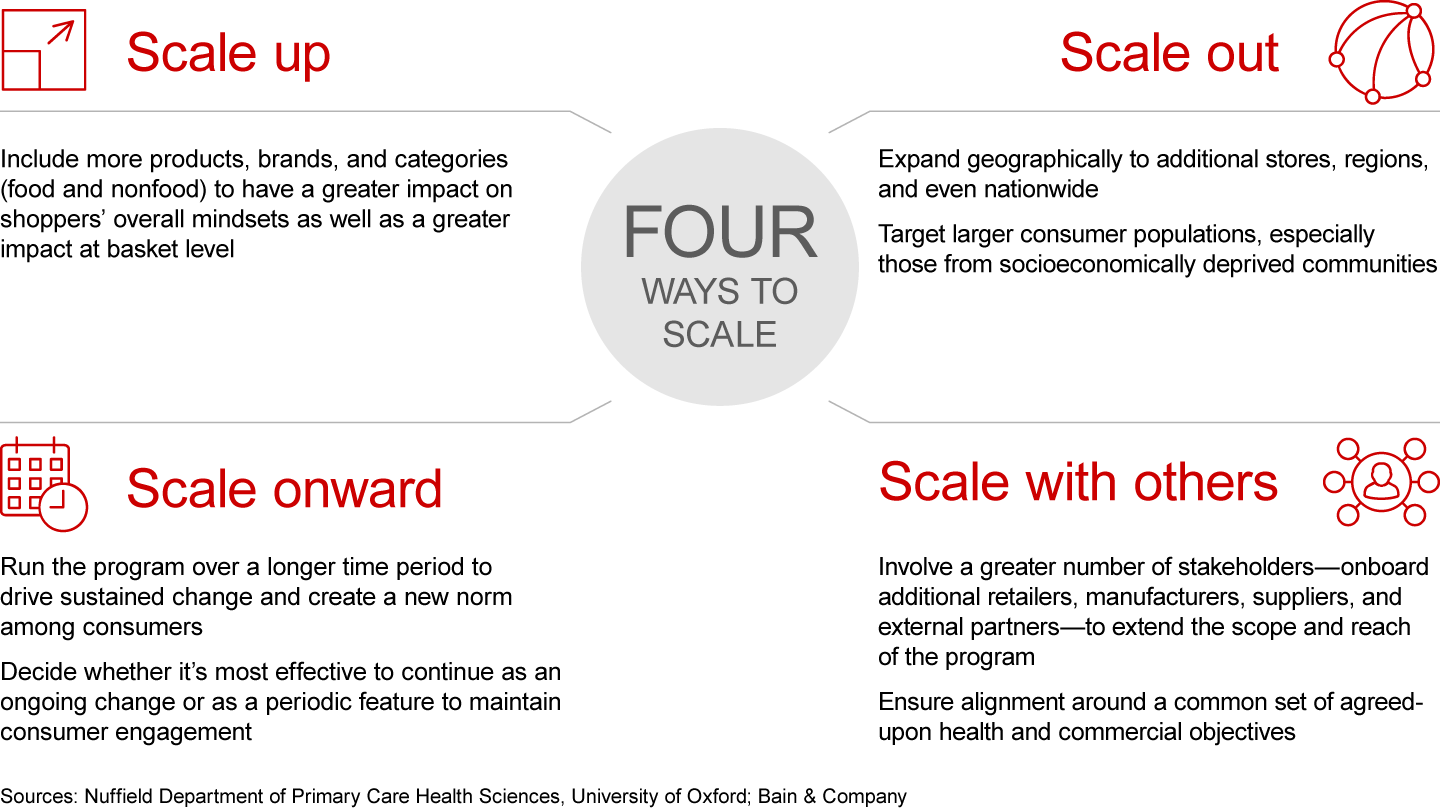
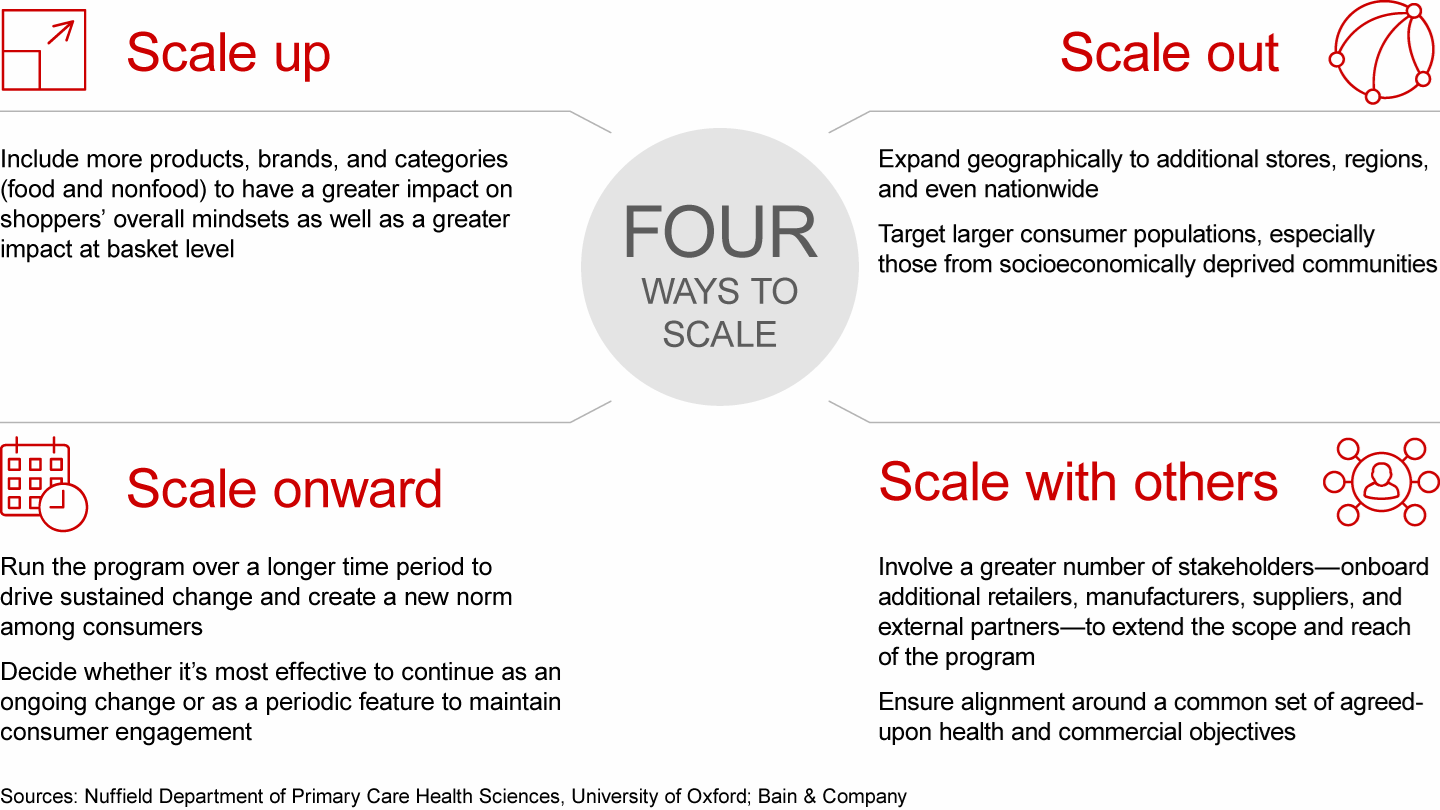
For example, Carrefour’s “On s’y met” digital pilot for CHL in France, including the creation and publication of four healthy recipes, originally involved four manufacturers and was limited to the Lyon area. The retailer has since expanded it nationwide, with five manufacturers now onboard.
Our analysis shows that there are several critical building blocks for successfully moving from pilot to wider rollout (see Figure 17).
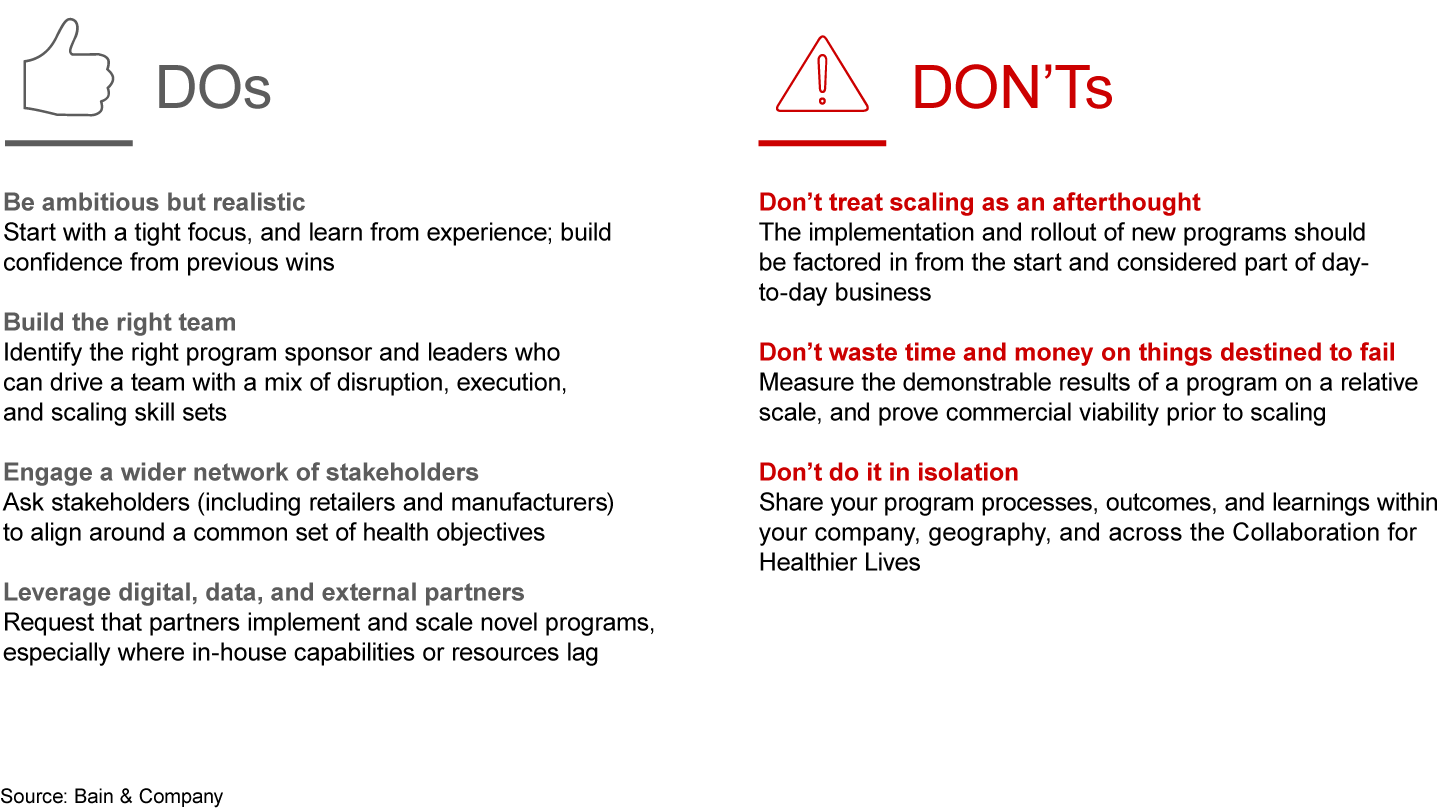
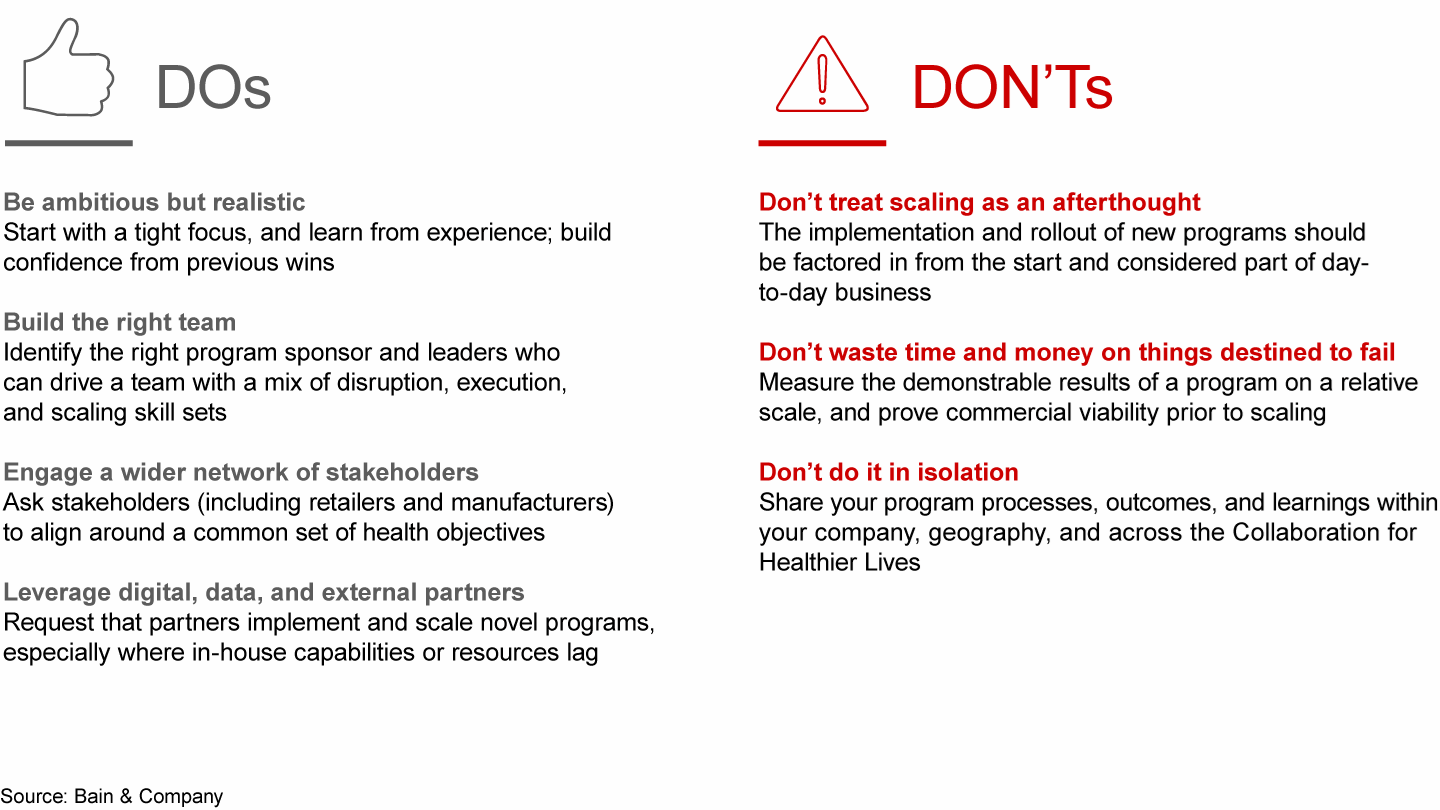
Set up programs correctly from the outset
Maintain clear objectives and scope—and make the commitment to learning from the experience. That means ensuring that the most important programs are set up to scientifically measure results against defined success criteria. Consider how the University of Oxford’s independent evaluation provided highly valuable insight into the relative success of CHL’s UK programs and whether they should be scaled.
Identify the right program sponsor and leaders who can provide senior advocacy and motivate a team with the right mix of disruption, scaling, and execution skill sets. Garner the support and organizational buy-in that will be required to prioritize and scale the program. For example, for CHL in Turkey, Migros Ticaret credited support from the CEO and top management as a key reason that it was able to rapidly scale.
Also important: Do not work in silos. Involve your data security officer from the start. Set up processes and systems to share learnings as efficiently as possible—within your company, within your market, and across CHL.
Do not treat CHL programs and their scaling as an afterthought—cocreate and embed them from day one
Both manufacturers and retailers need to cocreate and collaborate on programs to make adoption easier. Branded suppliers can choose to align with a retailer’s specific health objectives instead of rolling out identical programs across multiple competing retailers at the same time. Eventually, programs should be considered an important part of the business growth strategy and embedded in commercial and operational plans. Otherwise, they are bound to stall.
Demonstrate the impact and commercial viability of the pilots you plan to scale
Assess which elements of a pilot did or did not work in order to prioritize those to take forward and to identify the learnings to apply to subsequent programs. Demonstrate the commercial viability of programs that you plan to scale (e.g., shift of net sales to healthier SKUs, category growth, etc.). While there is a strong desire to encourage lasting consumer behavioral change, any program needs to make financial sense to all participating companies for it to be sustainable.
Leverage digital, data, and external partners to implement and scale programs
Companies boost the odds of success for rolling out programs at scale by harnessing the power of data and digital activation. This includes both programs targeting consumers through digital channels as well as digitization of physical in-store interventions (e.g., electronic displays). For example, as part of CHL in Turkey, Migros Ticaret enhanced its mobile app with personalized health reminders tailored to individuals' daily habits to encourage them to exercise, stay hydrated, and take care of their dental hygiene. Outside of the context of CHL, companies as diverse as Lurpak, Virgin Train, and Spotify have developed innovative approaches to using digital and data in a personalized way (see Figure 18). When companies lack the in-house digital capabilities or resources required to implement or scale such programs, they can find ways to collaborate with external partners, similar to how insurers around the world are working with Vitality (see Figure 19).
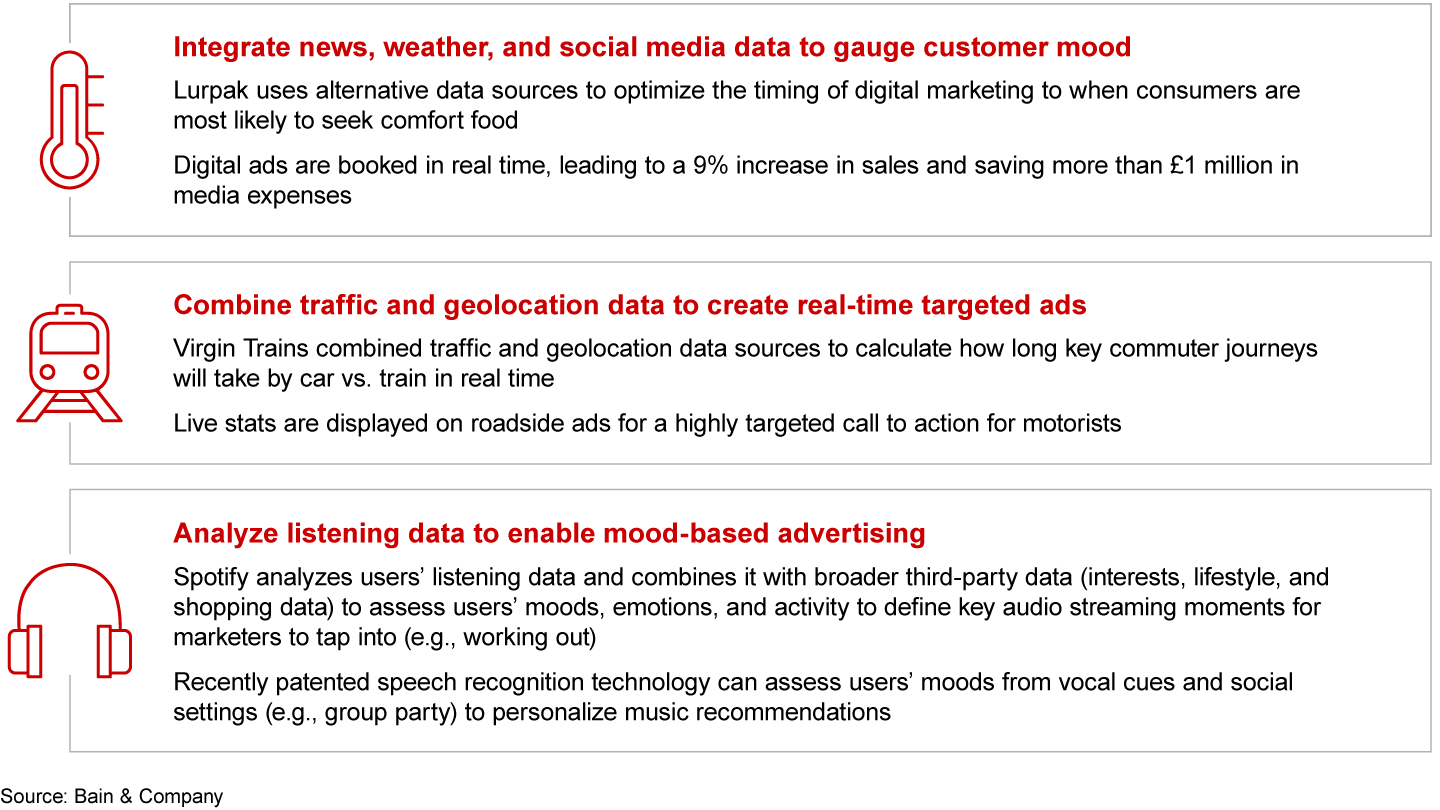
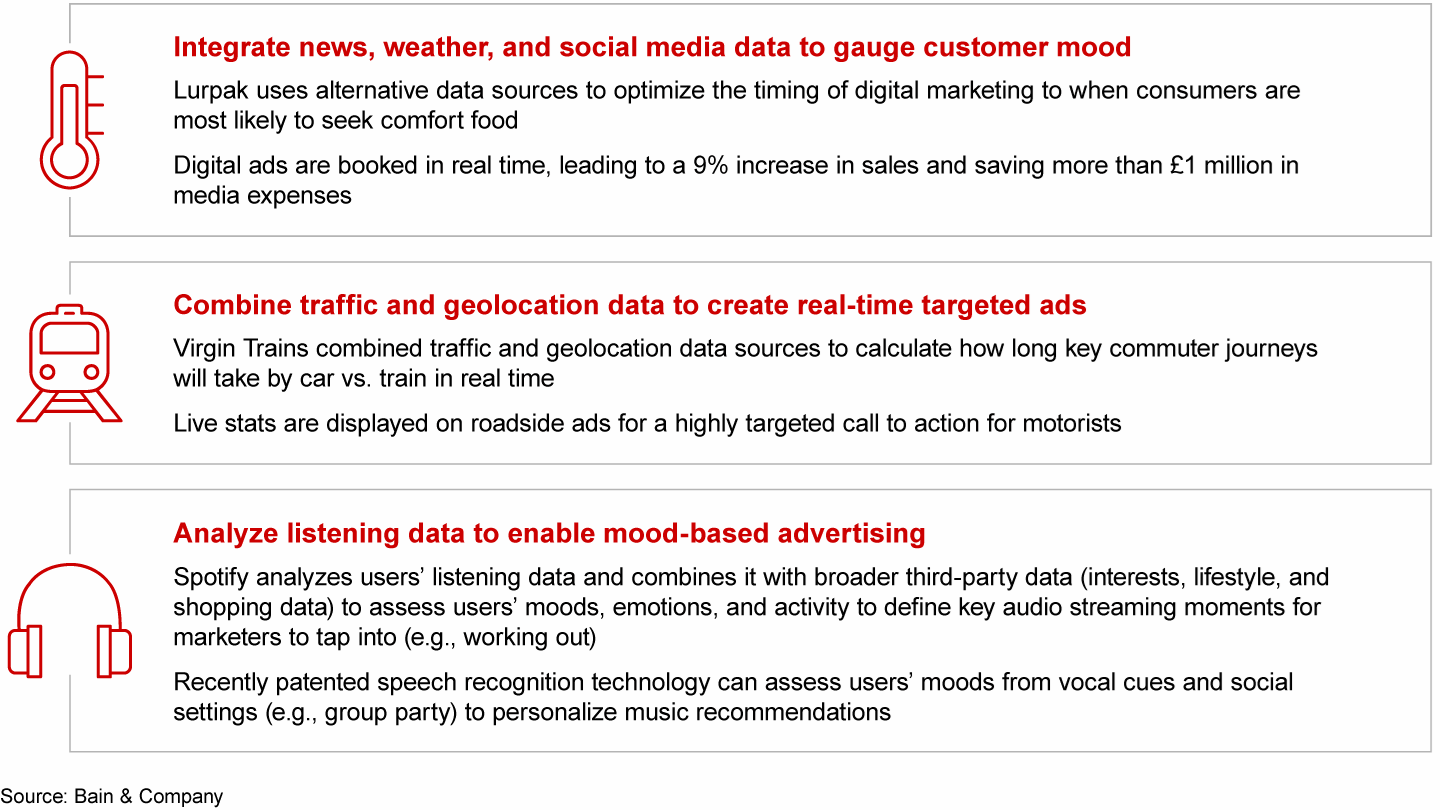
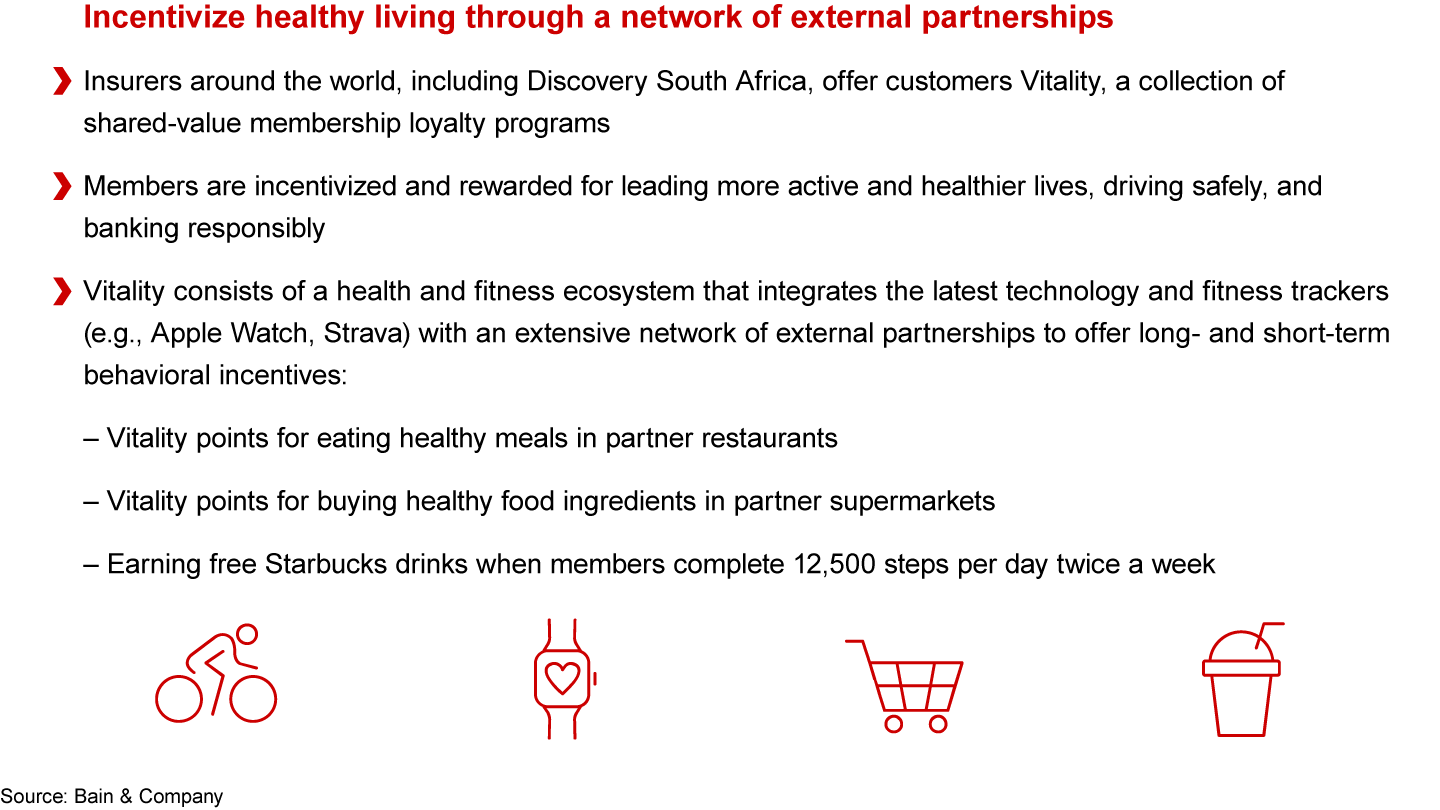
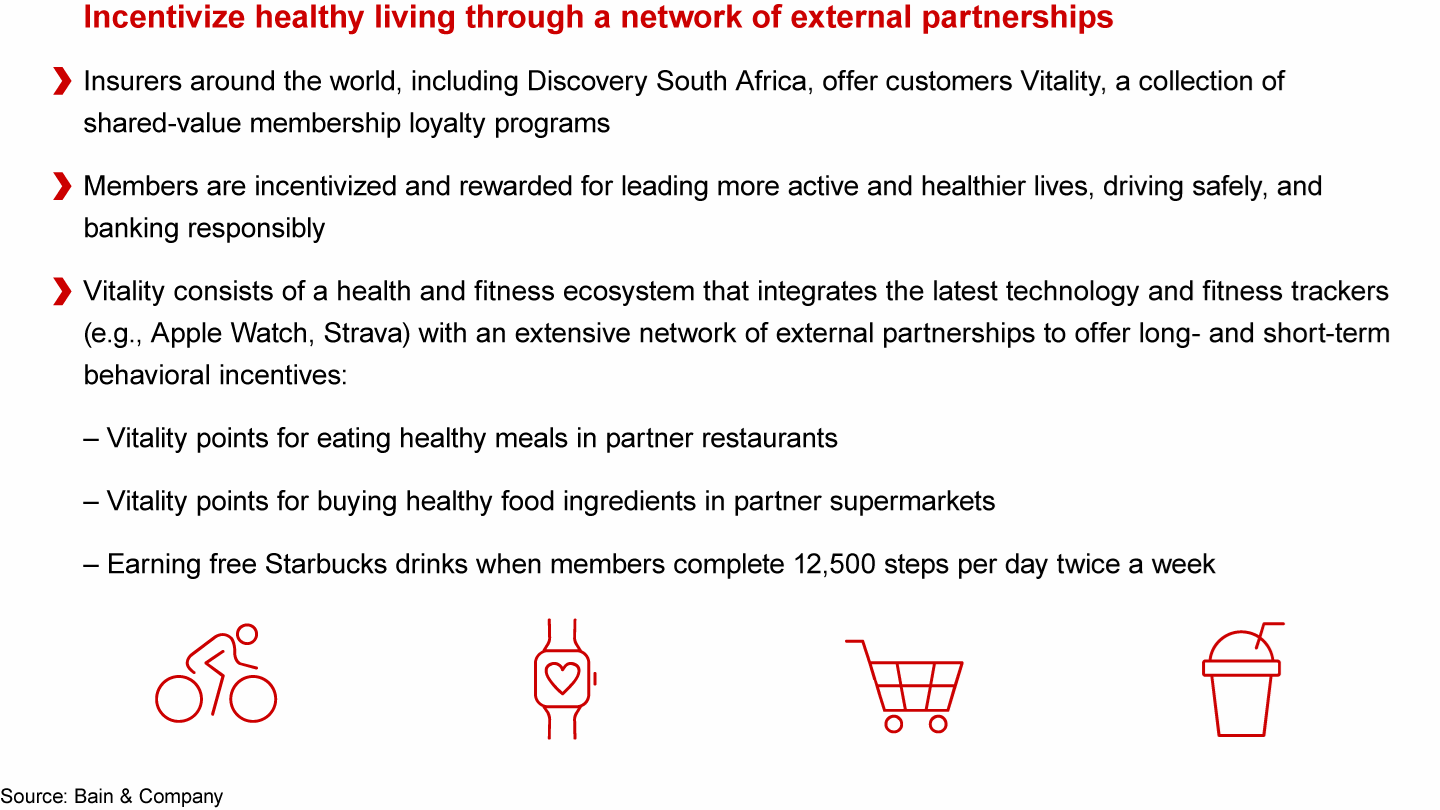
Although CHL has achieved significant tangible results to date, it can build on that success by aligning and focusing on its core mission of encouraging consumers to change their behavior by making healthier choices. Evaluate the extent to which current programs and corresponding resource allocations align with CHL’s priorities, and course correct when necessary. There is a risk of distraction, dilution of efforts, and erosion of credibility by concentrating on programs that are seemingly easy to implement but that may deliver less impact. Also important: balancing CHL’s expanding aspirations, such as broadening its remit to include sustainability, with maintaining focus and limiting complexity.
Finally, CHL can benefit from improving the current system for knowledge sharing, the Global Learning Mechanism, by finding a way for participants to easily codify and obtain the most critical learnings on the go, keeping them up-to-date and easily accessible for all (see Figure 20).
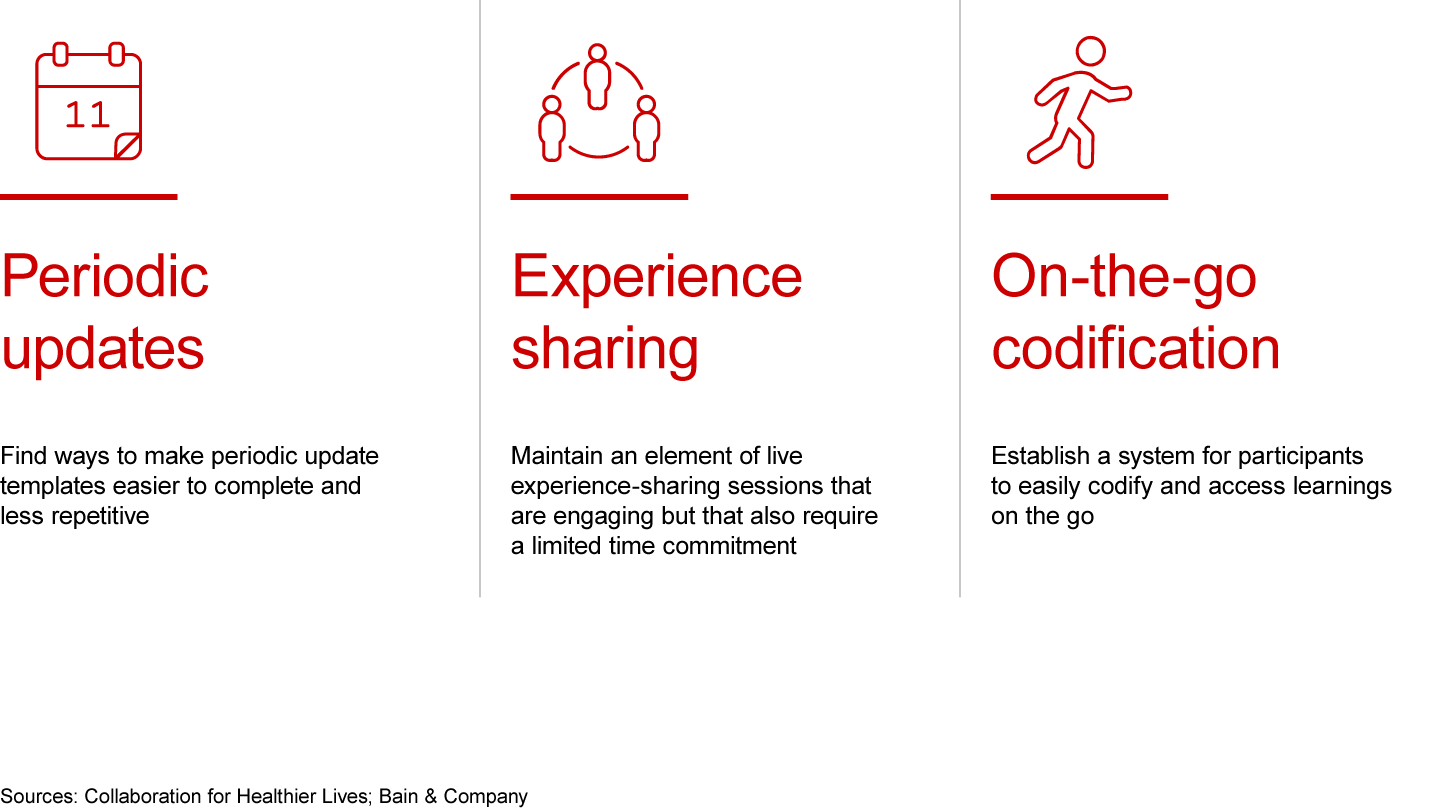
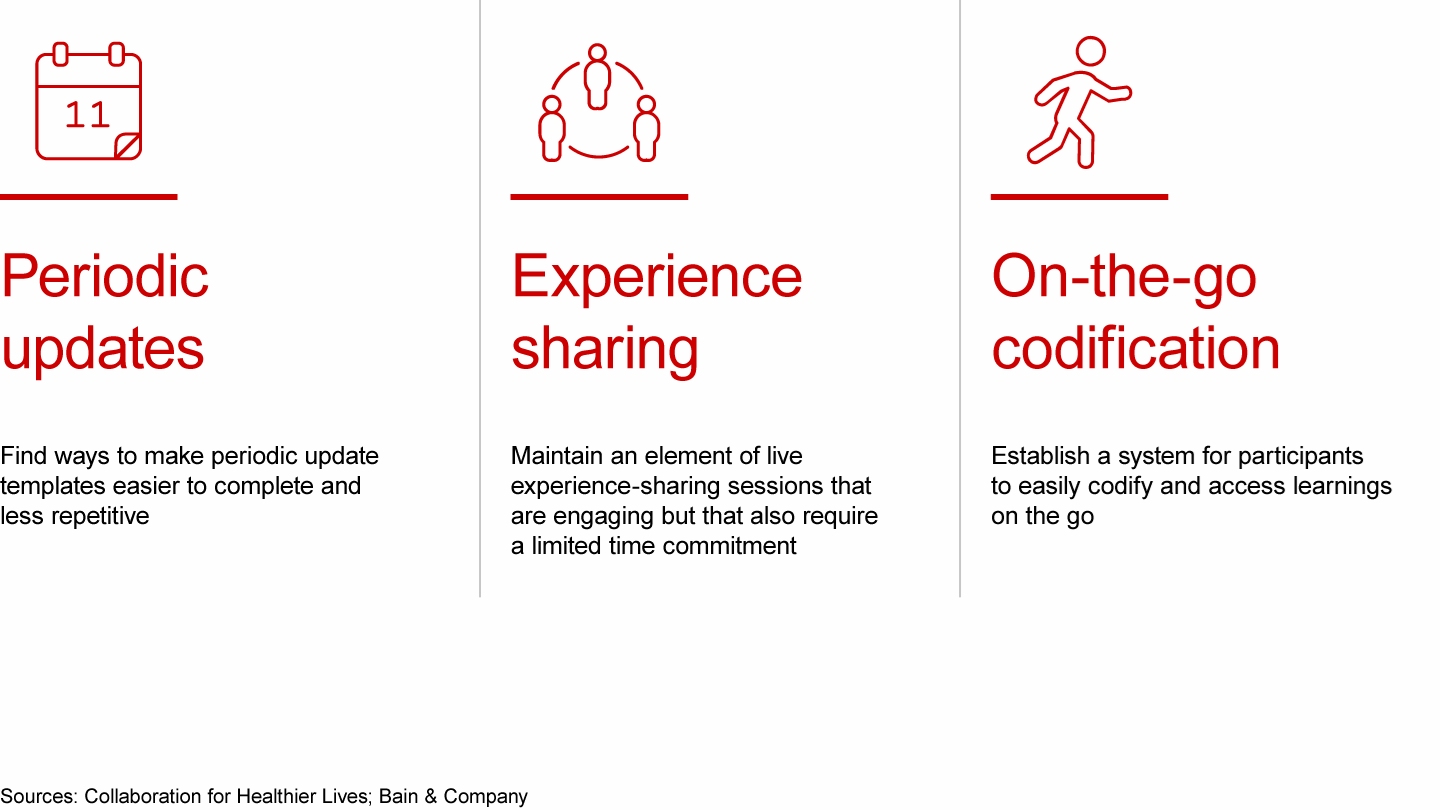
Appendix: About CHL and the methodologies used to assess its programs
Addressing health globally requires a multistakeholder approach. In this respect, the CGF is uniquely positioned to foster the right type of change. Indeed, it is the only CEO-led organization that brings consumer goods retailers and manufacturers together globally to help them collaborate—alongside other key stakeholders—to secure consumer trust and drive positive change. To move from statements to action, the CGF has launched several coalitions, including CHL, which pursues a mission to empower people in communities across the globe to lead healthier lives while creating shared value for business. There are currently more than 100 companies and organizations around the world involved with CHL initiatives, including academia and public health authorities such as Public Health England.
CHL establishes a precompetitive environment in which it can foster collaboration between retailers and manufacturers to address consumer health. Rather than being reactive to consumer demand or regulation, CHL has seized the opportunity to lead and shape what the future will look like, paving the way for improved consumer health.
As a member of the CGF, Bain & Company has partnered with CHL to take stock of the progress made to date, extract learnings across countries and programs, and develop a set of guidelines and recommendations for scaling programs that lead to demonstrated healthier behavior.
In order to facilitate this, Bain conducted a holistic review of programs to date, consisting of the following elements:
- Review of published CHL country-level reports and additional publicly available information (e.g., CHL country web pages) to collate all global CHL programs into a central repository and understand what types of changes have been implemented.
- Interviews with CHL members and partners, including the core CHL sponsorship team, CHL cochairs and local representatives for the 13 participating countries, the Behavioural Insights Team, Oliver Wyman, KPMG, and academic institutions such as Insead, the University of Oxford, and McGill University. Interviews provided an opportunity for more in-depth, qualitative discussions about individual success stories, challenges encountered, lessons learned, and themes emerging across regions.
- Analysis of self-assessments completed by CHL members. Given the wide variability across countries, in terms of both types of programs implemented and the different levels of outcome tracking, country cochairs were asked to complete a standardized self-assessment form to evaluate the relative success and feasibility of each program. Self-assessments were submitted by 12 of the 13 countries (with a partial completion by one country); the remaining program was excluded from detailed analysis related to success and implementation feasibility.
Evaluation of CHL’s work to date followed a structured approach in which programs were categorized across several key dimensions.
- Target audience: consumer/shopper vs. employee (with our analysis focusing primarily on the consumers/shoppers)
- Category: food vs. nonfood vs. both
- Channel or mode of implementation: physical (in store and out of store) vs. digital (company app/website and social media/search engines) vs. both
- Goal: increase consumer awareness/educate on health-related topics vs. alter the shopper environment vs. both
- Activation archetype: programs were grouped into several archetypes based on the nature of change implemented (e.g., in-store demonstrations vs. promotional pricing vs. product displays, etc.)
Programs often incorporated more than one intervention, such as multiple in-store promotions, and were often multidimensional. It is important to note that such dimensions are not necessarily mutually exclusive for a given program. For example, a single program may be implemented both in store and online, may aim to raise consumer awareness as well as altering the shopping environment, and may involve several activations. Figures 21 and 22 outline the framework used to define different activation archetypes for targeting consumers/shoppers and map these to the relevant channels and goals (see Figures 21 and 22).
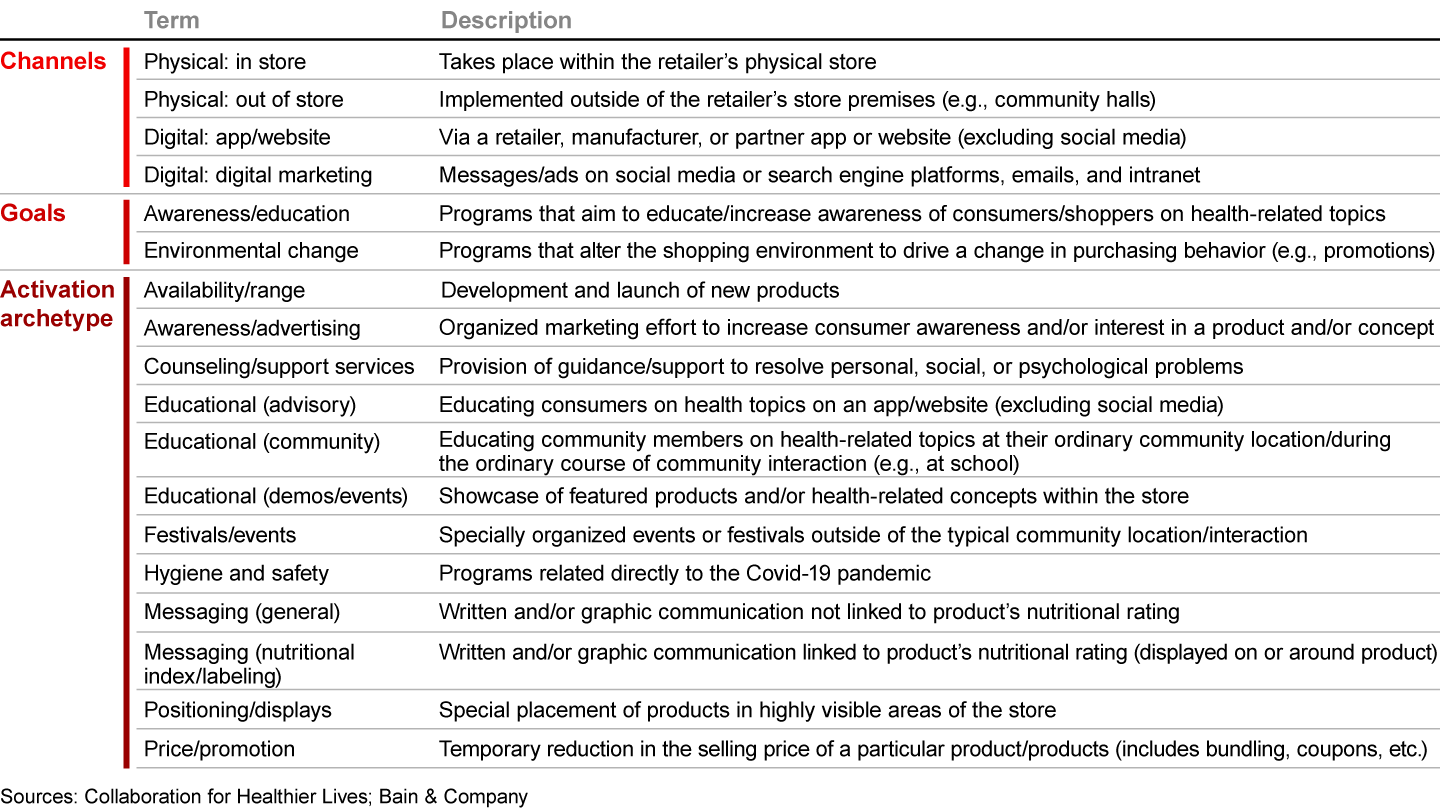
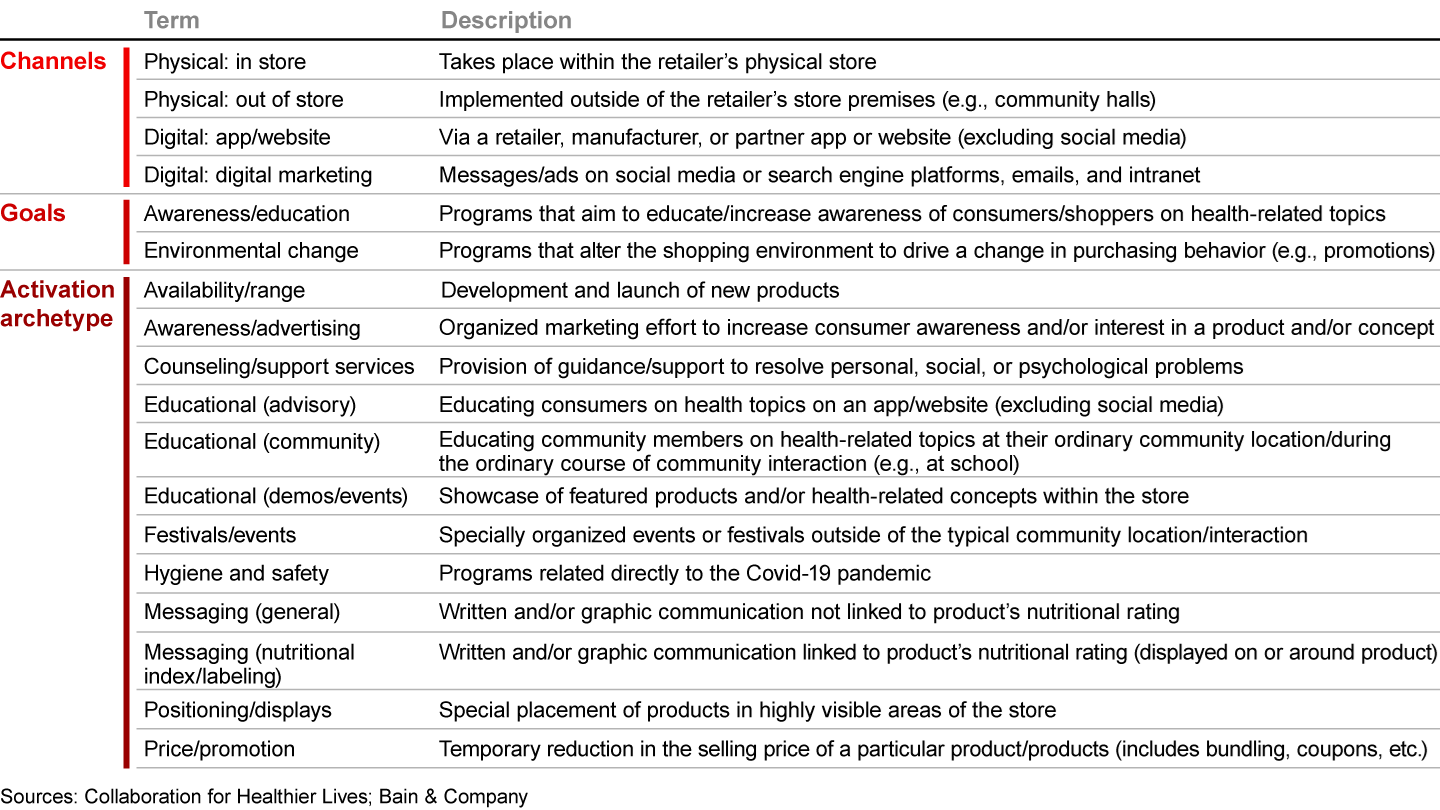
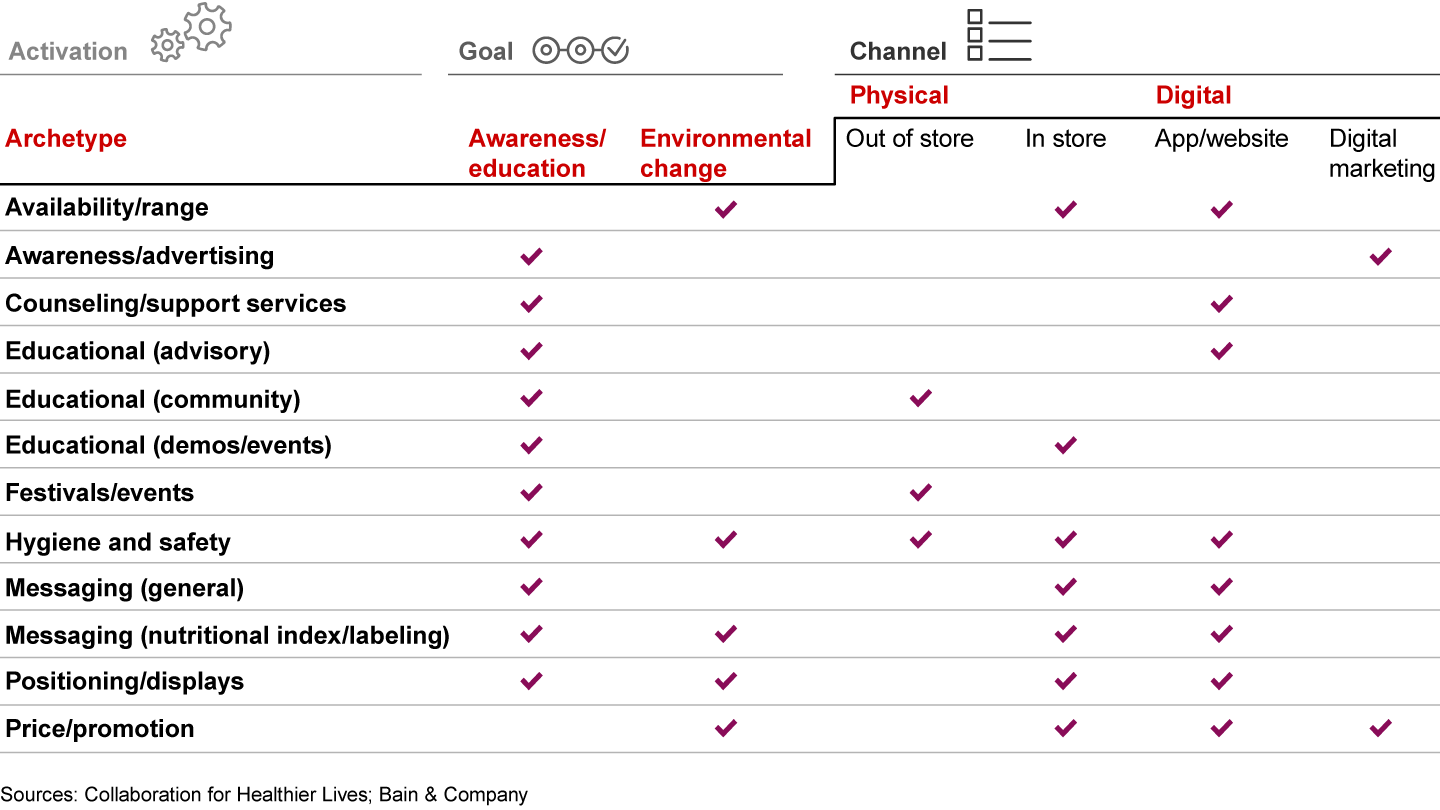
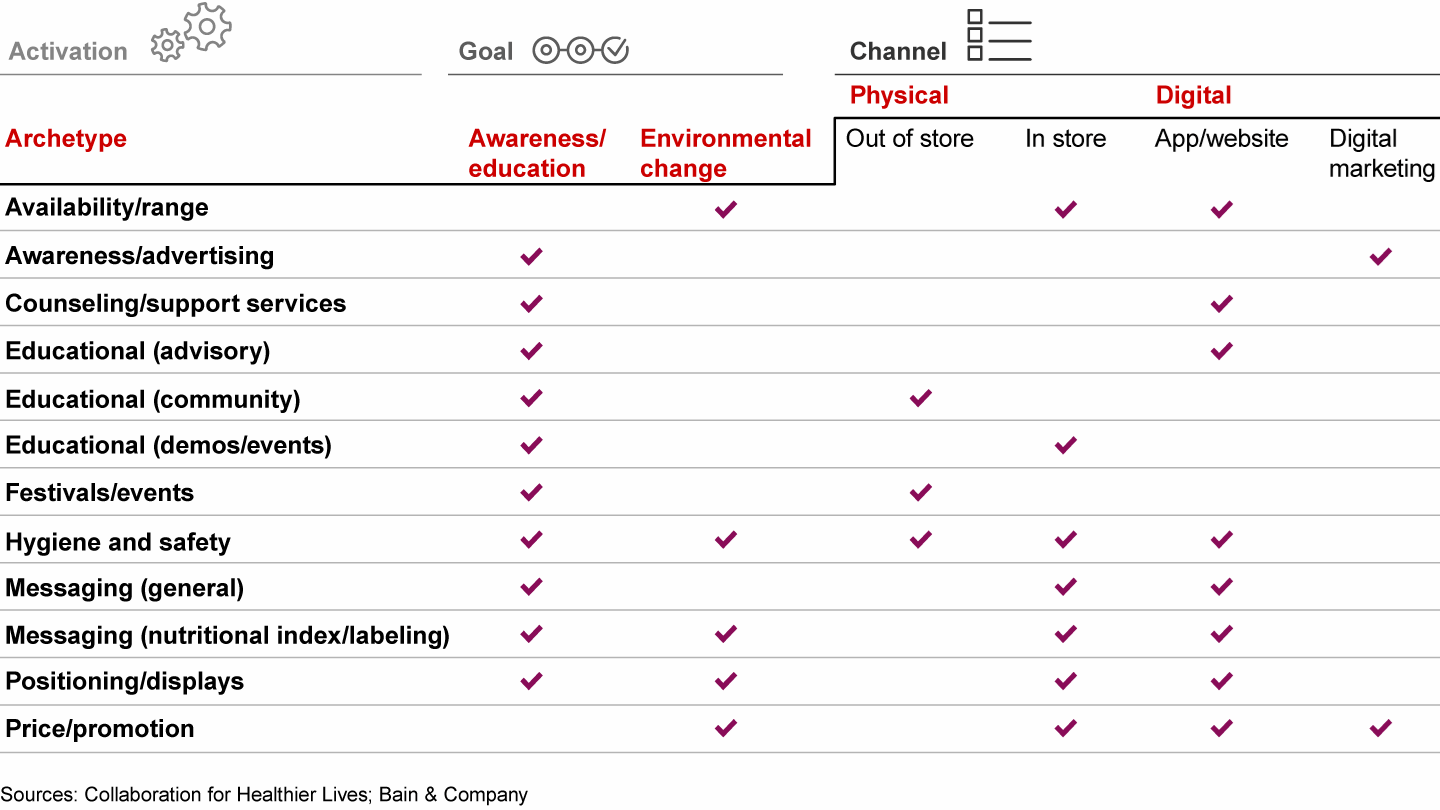
Participants were asked to complete a standardized self-assessment template to evaluate the outcomes of each program on a relative scale across two core dimensions: program success and implementation feasibility. Success was scored on a four-point scale ranging from “not at all successful” to “very successful” for both raising consumer awareness and leading to actual behavioral change. Feasibility was scored on a four-point scale ranging from “slightly difficult” to “extremely difficult” for cost to achieve, time required, labor intensity, and level of organizational buy-in. Quantitative analysis of self-assessments allowed this report to identify which activation archetypes, channels, and goals were most closely associated with successful outcomes and easy implementation. The combination of self-assessments and academic behavioral sciences research was used to develop recommendations for the types of programs CHL should choose as the focus of future pilots and scaling.
The authors would like to thank Cara de Bruyn for her contribution to this work.

About The Consumer Goods Forum
The Consumer Goods Forum (CGF) is a global industry network whose members encourage the global adoption of practices and standards that serve the consumer goods industry. It gathers CEOs and management teams from some 400 retailers, manufacturers, service providers, and stakeholders across 70 countries that have combined sales of €3.5 trillion and that directly employ 10 million people. Its board comprises 57 manufacturer and retailer CEOs. For more information, visit www.theconsumergoodsforum.com.

About Collaboration for Healthier Lives Coalition
The CGF’s CEO-led Collaboration for Healthier Lives (CHL) coalition is about making it easier for people around the world to adopt healthier lives. CHL is a global movement led by manufacturers, retailers, public health authorities, and local communities that generates action worldwide. Members and partners are collaboratively exploring and evolving business models, and sharing data and knowledge at scale to support positive change. For more information, visit www.tcgfhealthierlives.com.